
- Classic Movies and Documentaries
Classic Movies and Documentaries
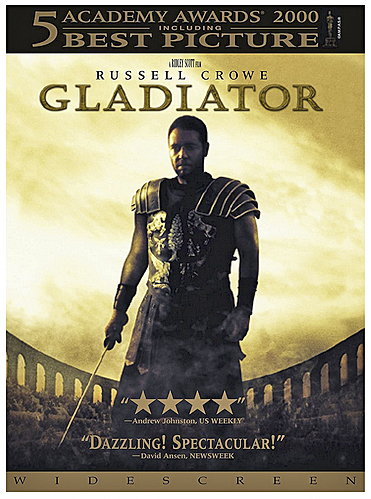
Gladiator (2000)
Directed By: Ridley Scott
Starring: Russell Crowe, Joaquin Phoenix, Connie Nielson, Oliver Reed, Richard Harris, and Derek Jacobi.
Music: Hans Zimmer and Lisa Gerrard
Brief Description: This movie recounts the reign of the evil Roman Emperor Commodus (AD 180-92), son of the philosopher Emperor Marcus Aurelius, who ended the golden age of the Adoptive Emperors. While in the movie, Commodus (Joaquin Phoenix) strangles his father Marcus Aurelius (Richard Harris), in historic truth Marcus Aurelius allowed his immoral son to become emperor. The fictitious character of the former general Maximus turned Gladiator is played by Russell Crowe in a magnificent performance. Oliver Reed delivers his last performance to perfection. The movie is 2 hours and 35 minutes long and is worth every minute of viewing. I agree with David Ansen of Newsweek, who called the movie “Dazzling! Spectacular!”
The story plot is very well summarized by Emperor Commodus in the movie who tells Gladiator in the arena: “The General who became a slave. The slave who became a gladiator. The gladiator who defied an empire.”
The costumes, Roman armaments, the legions, the barbarian hoards, and the gladiatorial games, the Colosseum, and the landscape are all spectacular, even if some were digitally created. Everyone should see this movie!
Rating: 5-star epic, historic movie recommended by MAF.
Theatrical Trailer: http://www.youtube.com/watch?v=KCEf88NkVWI
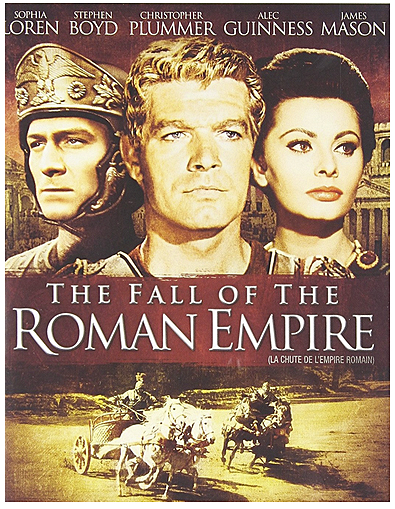
The Fall of the Roman Empire (1964)
Starring: Sophia Loren, Stephen Boyd, Christopher Plummer, Alex Guinness, Anthony Quayle, James Mason, John Ireland, Omar Sharif, Mel Ferrer
Directed by: Anthony Mann
Brief Description: Honorable mention should be made of the 1964 film classic The Fall of the Roman Empire starring Sophia Loren (as Lucilla, daughter of Marcus Aurelius), Stephen Boyd (as the Roman General Livius, instead of Maximus), Christopher Plummer (as Commodus), Alec Guinness (as Emperor Marcus Aurelius), and Anthony Quayle (as Verulus, ex-gladiator and the head of the Praetorian guard). Supporting cast includes actors James Mason, John Ireland, Omar Sharif and Mel Ferrer, just to name a few. Read no further if you intend to watch this movie, as I do not want to give away the ending for those who have not seen it.
The big twist in “The Fall of the Roman Empire” refers to the lack of constancy, to put the matter kindly, of both Faustina the Elder, the wife of the Emperor Antoninus Pius, who preceded Marcus Aurelius, and her daughter, Faustina the Younger, the wife of Marcus Aurelius. Aurelius was a excellent writer and stoic philosopher, not to mention a warrior emperor, but he was not a good judge of character; his co-emperor, Lucius Verus, who died of the plague early, was a mediocrity; Aurelius’s wife was not faithful to him but he loved her and after her death literally worshipped her; Commodus was not disinherited and, in reality, succeeded Aurelius of the latter’s own volition, ending the magnificent golden and enlightened rule of the Adoptive Emperors — from Nerva (reign A.D. 96-98) through Trajan, Hadrian, and Antoninus Pius, to Marcus Aurelius (reign A.D. 161-180).
In this Hollywood rendition, Commodus learns straight from the horses mouth so to speak, the head of the praetorian guard who had been so protective and loyal to Commodus, that he, Verulus, was Commodus’s true biological father. In a rage, Commodus kills Verulus. The end of the movie is partially historically accurate and partially Hollywood predictable. Those who have seen “Gladiator,” a non-stop, action-packed drama, may find this film a bit too slow for their fast-pace, modern taste. Nevertheless, “The Fall of the Roman Empire” is also a good film and deserves a 4-star rating, even though it is definitely surpassed by “Gladiator,” a tremendous film I truly did not think would or could be made today. My hat remains tipped to the “Gladiator” master Director Ridley Scott and superstar Russell Crowe.
Rating: 4 stars recommended by MAF.
Theatrical Trailer: https://www.youtube.com/watch?v=yJlxa64mKro
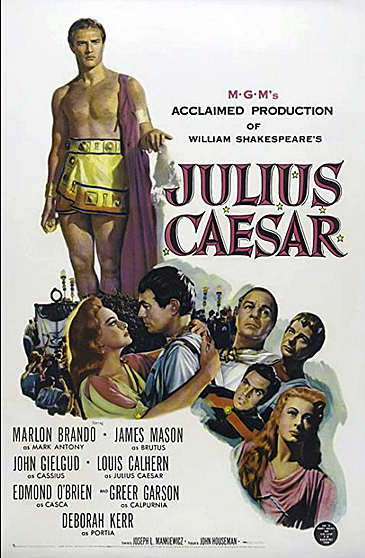
Julius Caesar (1953)
Starring: Marlon Brando, James Mason, John Gielgud, Louis Calhern, Edmond O’Brien, Deborah Kerr, Greer Garson
Directed by: Joseph L. Mankiewicz
Brief Description: Honorable mention should be made of the 1953 film classic Julius Caesar. This is one of the best films on the fall of the Roman Republic. This magnificent film, although adapted from Shakespeare, makes a fairly accurate portrayal of the final turbulent years of the civil war that befell ancient Rome at the death knell of the Republic. As I wrote elsewhere,”… in many aspects of the personalities of the Romans, as depicted in such a film as Julius Caesar (1953) — e.g., Marcus Brutus, Gaius Cassius, Julius Caesar, Marc Antony, and Porcia, played by James Mason, John Gielgud, Calhern Louis, Marlon Brando, and Deborah Kerr, respectively — the character portrayal of the historic Roman figures in the film’s version come closer to the truth than in Colleen McCullough’s historic novels. This magnificent film, in fact, I recommend to the reader as a partial counterpoint to McCullough’s The October Horse (2002).” I recommend this epic historic film to our readers without caveats and as an introduction to the fascinating history of the late Roman Republic.
Rating: 5 stars recommended by MAF
Theatrical Trailer: http://www.youtube.com/watch?v=o5cJKCbbHeo
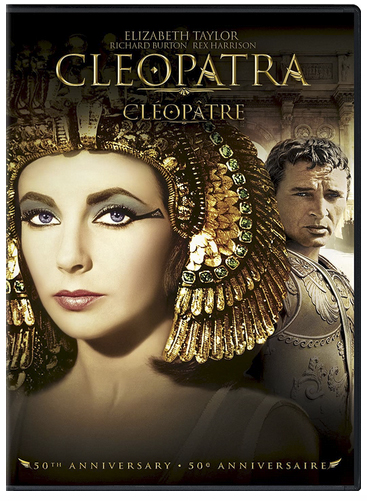
Cleopatra (1963)
Directed By: Joseph L. Mankiewicz
Starring: Elizabeth Taylor, Richard Burton, Rex Harrison, Martin Landau, Roddy McDowall, Carroll O’Connor, Hume Cronyn
Music: Alex North
Brief Description: This is a truly historic film of Epic proportions, four magnificent and enthralling hours of action-packed, exhilarating drama and suspense! This marvel of cinematography keeps us dazzled with the enchantment of history, in all her glory, unfolding before our disbelieving eyes; it also educates us about entwined events at the end of the Roman Republic, fateful turning points of turbulent Roman history.
Rex Harrison plays Julius Caesar with flair and distinction, giving credit to Julius Caesar the dictator of Rome. Mark Antony is played with all his Roman attributes but also his very human and fatal foibles by Richard Burton. A ruthless and unforgiving Octavian is played by Roddy McDowall. Cleopatra, Queen of the Nile and Pharaoh of Egypt, Isis on earth, is played by Elizabeth Taylor with all her beguiling charms, dazzling beauty, and full Egyptian (Ptolemaic) splendor!
The VHS cover reads: “Elizabeth Taylor, Richard Burton, and Rex Harrison star in this sweeping tale of power and betrayal — the legendary story of the Queen of the Nile and her conquest of Julius Caesar and Marc Antony. Here is the truly unforgettable portrayal of the beguiling beauty who seduced two of Rome’s greatest soldiers and changed the course of history. Breathtaking in scope and grandeur, the picture won Oscars for cinematography, art direction, costumes, sets and special effects. In the tradition of epic romantic adventures … comes the greatest spectacle of all … Cleopatra.”
The movie begins with Caesar’s defeat of Pompey the Great and the Republican forces at the Battle of Pharsala in 48 B.C. and ends with the invasion of Egypt and Alexandria by Octavian in 30 B.C., following the defeat of Mark Antony and Cleopatra at the Battle of Actium the previous year. It covers Caesar’s occupation of Alexandria, his meeting with Cleopatra (who is dramatically brought to him rolled within a Persian rug) and their ensuing love affair; Caesar’s return to Rome, his intriguing for absolute power in Rome and the consequent conspiracy of Brutus, Cassius and the Republicans resulting in Caesar’s assassination on the Ides of March in 44 B.C; the Battle of Philippi in 42 B.C.; the seduction of Antony by Cleopatra and their bid for power that ends in the shameful and crushing defeat at the Battle of Actium in 31 B.C.; and finally the Roman the conquest of Egypt and the dramatic suicides of Antony and Cleopatra, resulting in the end of Ptolemaic Egypt and the Hellenistic period of ancient history. Rome and Octavian rule supreme and the era of the Roman Empire is initiated with Octavian becoming “Augustus,” the first Emperor of Rome.
Rating: 5 star epic, historic movie recommended by MAF.
Theatrical Trailer: http://www.youtube.com/watch?v=mTCJDy0Ngi8
Notable mention should also be made of several films that appeared in rapid succession between 2006 and 2011 in the genre of Ancient Rome in general and Roman legionaries in particular. These movies almost reach heroic, epic status but fall slightly short. Nevertheless, they are entertaining, historic fiction adventures that take place in the mid to late stages of Rome and the Western Roman Empire. The first two movies deal with the 9th Roman Legion that was lost in Scotland fighting the Picts and Scots. The third movie deals with the last and mythic Roman Legion that supposedly escaped from the devastation of Rome in A.D. 476. I mention these three movies of the Roman Empire in descending order of excellence:
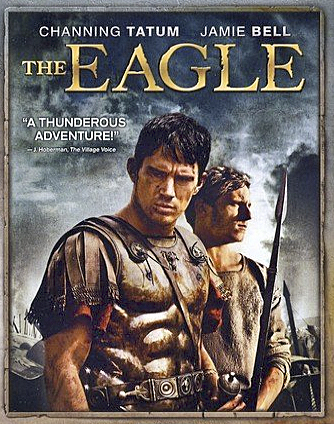
The Eagle (2011)
Starring: Channing Tatum, Donald Sutherland
Directed by: Kevin Macdonald
The DVD cover reads: “In 2nd-Century Britain, celebrated Roman soldier Marcus Aquila (Channing Tatum) embarks on a dangerous quest to restore the tarnished reputation of his father and find the golden emblem that disappeared with him and thousands of troops twenty years earlier…”
Rating: 5 stars
Theatrical Trailer: http://www.youtube.com/watch?v=3TLYO2I5kgw

Centurion (2010)
Starring: Michael Fassbender, Dominic West
Directed by: Christian Colson
As with “The Eagle” mentioned above, “Centurion” also relates to the mysterious fate of Rome’s Ninth Spanish Legion (Legio Nona Hispana), which was lost in Scotland about AD 117 during the reign of Emperor Hadrian and deals with heroic Romans fighting the savage Scots and Picts in the northern frontier of the empire.
Rating: 5 stars
Theatrical Trailer: https://www.youtube.com/watch?v=KOZs2_i_cDE

The Last Legion (2007)
Starring: Colin Firth, Ben Kingsley, Aishwarya Rai
Directed by: Doug Lefler
The Last Legion is set during the actual fall of Rome and the Western Roman Empire and depicts what became of the Roman kingmaker Orestes and his son, the last Emperor, the child Romulus Augustulus, which ties a couple of disparate legends together.
Rating: 4 stars
Theatrical Trailer: https://www.youtube.com/watch?v=p-01n4dptzg
Notable Mention: The next three films that deserve notable mention are:
Agora (2010; 4 stars), set in AD 415-416 at the time of religious strife in the ancient Hellenistic city of Alexandria.
The Final Inquiry (2008; 4 1/2 stars) takes place at the time of Emperor Tiberius and is all fiction. It’s vaguely reminiscent of the chariot epic Ben-Hur.
Coriolanus (2012;1 star). I was greatly disappointed in this movie because it was not even about the Roman Coriolanus!
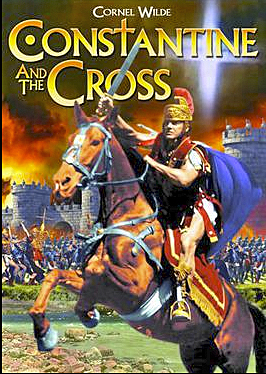
Constantine and the Cross (1961)
Starring: Cornel Wilde, Massimo Serato, Belinda Lee, and
Christine Kaufman
Directed by: Lionello de Felice
Dramatic biblical film on the life of Constantine the Great (Emperor, A.D. 302-337) and his adoption of Christianity for the Roman Empire after his decisive victory over Maxentius at the Battle of the Milvian Bridge in A.D. 312. Although the film takes some novelistic license, it is largely based on factual historical information. The movie does not neglect the historic figures of the time: the Tetrarchy of Emperors including Diocletian, Maximian, and Constantius Chorus (father of Constantine).
A major player is Fausta, (played by Belinda Lee, a Sophia Loren look-alike beauty). She is the daughter of Emperor Maximian, and the object of love of Constantine (played magnificently by Cornel Wilde). She is also the sister of the cruel and treacherous antagonist and eventual archenemy of Constantine, Maxentius (played by Massimo Serato), Emperor of the West and master of Rome. The cinematography is outstanding; the Christian persecutions accurately portrayed; the military and senatorial regalia consistent with the times; the dialogue convincingly plausible; the battle scene realistic; the plot and historic events largely factual. The movie takes place roughly from AD 301 to 312, and is highly recommended for lovers of Roman historical dramas and epic films.
Rating: 5 stars

Apocalypto (2007)
Directed By: Mel Gibson
Starring: Gerardo Tracena, Raoul Trujillo, Dalia Hernandez, Rudy Youngblood, Jonathan Brewer
Music: James Horner
Brief Description: A mesmerizing epic adventure with which few viewers may be familiar. Mel Gibson has created another thrilling and historic epic about Mesoamerican culture and Mayan civilization, including one of the most compelling features of Mayan civilization, and that is the practice of bloody human sacrifice on a mass scale!
In a non-stop action performance, the movie follows the main character, Jaguar Paw (Rudy Youngblood) as he is captured along with others from his tribe and taken to a great Mayan city for ritual sacrifice. Raoul Trujillo gives a credible performance as the Mayan chieftain and hunter of sacrificial victims who pursues Jaguar Paw through the jungle for blood thirsty revenge.
The production description summarizes the movie’s plot as follows: “Driven by the power of his love for his wife and son, [Jaguar Paw] makes an adrenaline-soaked, heart-racing escape to rescue them and ultimately save his way of life. Filled with unrelenting action and stunning cinematography, APOCALYPTO is an enthralling and unforgettable film experience.” And, I agree!
Mayan historians collaborated with director/producer Mel Gibson to recreate costumes and scenery that are frankly out of this world. The Mayan city is reconstructed from available historic and archeological sources. The sacrificial rituals are stunning.
This movie is an unforgettable visual experience set in the jungles of Mesoamerica in what was the Land of the Maya just before the arrival of the Spanish Conquistadors.
Rating: 5-star epic, historic film based on documented Mayan culture; recommended by MAF.
Theatrical Trailer: https://www.youtube.com/watch?v=gSw5l5jMnPM
I would be remiss if in the context of this magnificent film, “Apocalypto,” I did not travel back a few decades to mention another spectacular film also dealing with the bloodthirsty Mayans of Mexico and Central America, a splendid civilization as intriguingly preoccupied with the cycles of time as with the performance of ritualistic human sacrifices, although not quite on the same gigantic scale as the Aztecs. The Mayans utilized no metals but obsidian stones, used no draft animals or the wheel to construct their colossal pyramids or temples, and yet their knowledge of mathematics was outstanding and their calendar as accurate as ours.
The 1963 film “Kings of the Sun” is a totally enchanting and memorable movie — a movie from my childhood that left a vivid impression in my mind. So much so that more than twenty years later, when VHS videotapes came into vogue, I avidly hunted down this movie for my classic film collection. In this category are other movie wonders as “The Man from Rio” (1964; starring the intrepid French actor, Jean-Paul Belmondo); several Samurai epics of the late 1950s or early 1960s most of them directed by Akira Kurozawa and starring Toshiro Mifune, including “The Samurai Pirate” (1963),” “The Seven Samurai (1954),” “Sanjuro (1962),” “Yojimbo (1961),” and “Harakiri” (1962). There were even a couple of American films impressed on my mind, films like “Tarzan’s Greatest Adventure” (1959) starring Gordon Scott and Anthony Quayle, and “Some Like It Hot” (1959) starring Tony Curtis, Marilyn Monroe, Jack Lemmon, and George Raft — two American films, which somehow went through the net of censors in communist Cuba!
Why are there so many foreign films on my list? Because my early childhood was spent in my native country, Cuba, a nation which embroiled in Revolution became in 1959 a communist enclave in the Western hemisphere and an island prison, so that by 1961 the American movie repertoire was very limited, and foreign films had become the norm, although indoctrinating Soviet or Eastern European films did not make my list of classics!
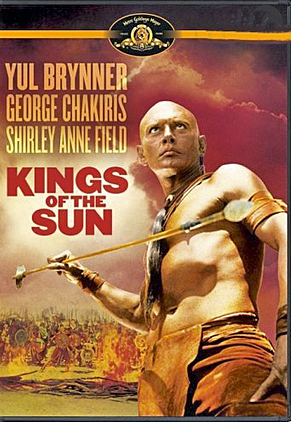
Kings of the Sun (1963)
Starring: Yul Brynner, Georgie Chakiris, Shirley Anne Field
Directed by: J. Lee Thompson
Brief Description: Returning to “Kings of the Sun, this is a spectacular film starring Yul Brynner (as Black Eagle), Richard Basehart (as the Mayan high priest), George Charakis (as the Mayan King Balam; “Jaguar” in Mayan) and Shirley Anne Field (as the Helen of Troy of the Mesoamerican jungle). Apparently the movie did not receive good reviews and consequently did not do well; so it was probably seen by relatively few Americans.
As the movie opens, Balam’s father, the old king, has died in battle, and Chichen Itza, the capital city is overwhelmed by hordes of ferocious warriors with tiara-like helmets and headdresses. The invaders are pouring over the steps of the main temple as the Mayans retreat. We assume the invaders are the feared Toltecs of Central Mexico (who in historic truth defeated the local Mayans of Yucatan and conquered Chichen itza at the end of the 10th century). These presumed Toltecs invaders are not led by the legendary leader Quetzalcoalt (A.D. 947-999) — half-man, half-god — but by a vindictive and implacable warrior, Hunac Ceel, bent on hunting down Balam and conquering his Mayan people. Moreover, Hunac Ceel and his warriors are armed with metallic swords (not historically accurate), while the defending and fleeing Mayans are armed with the typical Mesoamerican wooden swords edged with cutting obsidian stones (i.e., the razor sharp maquahuitls, as the Aztecs called them in their Nahualt language).
Balam and the Mayans barely escape, presumably from the northeastern coast of Yucatan (perhaps from Dzibilchaltun or even farther south from Tulum) where they pick up more of their people, maritime Mayans, and the beautiful Mayan princess, Ixchel, with the pursuing “Toltecs” on their tail. Sailing and rowing away to the north in the Gulf of Mexico, they land somewhere on a beautiful beach in northern Mexico or the southern U.S., where they now face new adventures and conflict with “uncivilized” tribes of the Gulf coast (probably not the Yaquis) more likely American Indians, led by Black Eagle (Yul Brynner), who is captured and destined to be sacrificed…The princess also becomes a bone of contention between Balam and the sacrificial victim, Black Eagle, who must be granted his final wish. This 1963 film imbued with both action and romance, of course, is relatively tame when compared with Mel Gibson’s (2006) breathless, action-packed masterpiece “Apocalypto,” but both films are unprecedented for their times — and classics for all times.
Rating: 5-stars, highly recommended by MAF.
Theatrical Trailer: https://www.youtube.com/watch?v=F00yWR000fE
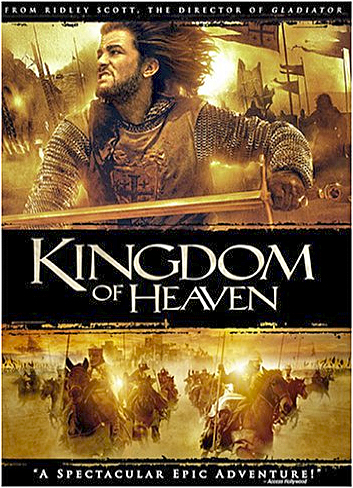
Kingdom of Heaven (2005)
Directed By: Ridley Scott
Starring: Orlando Bloom, Liam Neeson, Jeremy Irons, Eva Green, Ghassan Massoud
Music: Harry Gregson-Williams
Brief Description: The same magnificent director, Ridley Scott, who gave us Gladiator, has now given us another epic, historic film, “a thrilling, action packed, epic of honor, passion, and courage.” Orlando Bloom plays the young Crusader, a Christian knight, who fights to preserve the “kingdom of heaven,” the Latin kingdom of Jerusalem, from the onslaught of the Mamluk and Saracen armies led by the chivalrous Moslem knight, Saladin (1137-1193), Sultan of Egypt.
Historical background is necessary in order to understand this film. During the early Medieval period there were eight major Crusades from Christendom organized to reconquer the Kingdom of Jerusalem and/or restore one or more of the Latin Christian kingdoms of Palestine. The First Crusade ordered by Pope Urban II (1096-1099) was the most successful and it conquered Jerusalem from the Moslems. The Second Crusade (1147-1149) was inspired by the preachings of Saint Bernard of Clairvaux and ordered by Pope Eugenius III after the Latin kingdoms lost the city of Edessa to the Seljuk Turks in 1144. This Crusade ended in failure and the Latin kingdoms including the Kingdom of Jerusalem were left in a precarious situation, besieged on all fronts by the growing Islamic threat. Let us say here that the Eighth Crusade was the final campaign and that it also ended in failure. It brought an end to the city of Acre, the last Latin territory in the Holy Land. The Egyptian Mamluks were at last victorious.
[Note: The reader who wants to study further the history of Islam and the Moslem conquest of Arabia, the Near East and North Africa may want to peruse Dr. Miguel Faria’s “A Relevant and Brief History of Islam”. And the reader who wants to study further the background and history of the Crusades may want to peruse Dr. Miguel Faria’s “On the Spanish Inquisition and the Crusades”.]
The action in this movie takes place from about 1181-1187 in and around Jerusalem in the perilous period between the Second (1144-1150) and Third (1189-1192) Crusades. The hero of this saga is Balian of Ibelin (Orlando Bloom), a true historic figure. The character of Balian’s father, Godfrey of Ibelin (Liam Neeson), is a composite of Godfrey of Bouillon (1058-1100; leader of the First Crusade and brother of Baldwin I, founder of the dynasty of Latin kings of Jerusalem) and his real father, Barisan of Ibelin. In the earlier part of this movie, the King of Jerusalem is Baldwin IV, a just ruler but a leper who died at the young age of 24. He is succeeded by Guy de Lusignan who is married to Sybilla, the sister of Baldwin IV. All of these characters are true historic figures, who do in the film as they largely did in history. The instigator of much of the trouble in this movie as well as in history is Reynald de Chautillon, a savage knight bent on war for profit and who attacks Moslem caravans with impunity. Reynald’s insults and bellicosity become the primary reasons (or pretext) for Saladin to wage total war against the Kingdom of Jerusalem.
Good counselors to King Baldwin IV are Balian and Tiberias (Jeremy Irons), who do all they can to prevent war and preserve the “kingdom of heaven.” The character of Tiberias is based on the historic ruler, Raymond III of Tripoli (and allied Latin kingdom). The Christians are vastly outnumbered and led by a few hundred knights, among them the monastic orders of the Hospitalers and Templars. The Moslem armies number in the thousands and include Saracen warriors as well as the dreaded Mamluks. Following Baldwin IV’s death from leprosy, Guy de Lusignan assumes power and leads the Christian armies in the disastrous Battle of Hattin. The fate of the kingdom of heaven is sealed. Nevertheless, in 1187, Balian leads a heroic defense of the holy city of Jerusalem, knighting servants and peasants to increase the morale of the people in the besieged city. He helped man the fortifications and directed the city’s defenses.
The final battle for Jerusalem is a spellbinding spectacle and is accurately portrayed. Archers on the walls and towers shooting their deadly arrows at the Saracens storming the walls and trying to breach the fortifications; trebuchets launching their flaming missiles; “Greek fire” poured down and catapulted from the towers; “scorpion” missiles fired to and fro with deadly accuracy; slashing of scimitars and Damascene daggers; are all part of the battlefield extravaganza that is the siege and battle of Jerusalem.
Who wins? Who survives? You’ll have to watch the movie!
Let us just say that as the movie ends, the Third Crusade led by Richard I, the “Lion-Heart,” King of England (1189-1199); Frederick I, Holy Roman Emperor; and Philip II, King of France, was in the making.
Rating: 5-star epic, historic movie recommended by MAF.
Theatrical Trailer: http://www.youtube.com/watch?v=sndVnlLDFqI
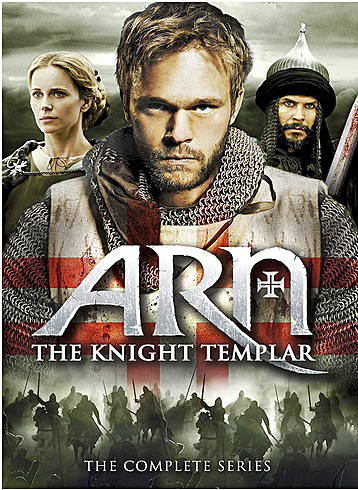
Arn: The Knight Templar (2007)
Directed By: Peter Flinth
Writers: Jan Guillou (novels), Hans Gunnarsson (screenplay)
Starring: Joakim Nätterqvist, Sofia Helin, Stellan Skarsgård
Brief Description: Arn: The Knight Templar (The Complete Series) is a spectacular epic based on the Crusades trilogy written by Swedish author and journalist, Jan Guillou. It features the fictional character, Arn Magnusson, a young Swedish nobleman, who becomes a Knight Templar as penance for having had a love affair with the maiden Cecilia, who is in turn sequestered in a monastery for twenty years. During this time, Arn becomes a great warrior in the Holy Land, participating in many historical events with historical characters. The complete series, a 6-part DVD miniseries, is a fabulous, epic masterpiece. The time sequence spans approximately the same time as the Kingdom of Heaven — the tumultuous period after the Second Crusade, the fall of Jerusalem and just before the Third Crusade. After Arn returns to his homeland in Gotaland, Sweden, he is forced to defend his clan against the contentions of a rival to the Swedish throne, a rival king who is supported by the Danish monarchy. A civil war ensues…. The DVD cover describes the plot: “In a land of brave knights, powerful queens and treacherous kings, Arn Magnusson, a skilled swordsman, is sent off to war as a Knight Templar as a penance for his sins. Separated from his love true love by a jealous nobleman, Arn must battle a cruel and violent world to survive.”
Rating: 5-star epic, historic movie recommended by MAF
Theatrical Trailer: http://www.youtube.com/watch?v=1EAqu28Dd-M
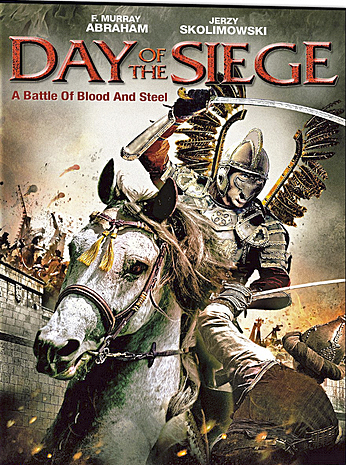
Day of the Siege (2013)
Directed By: Renzo Martinelli
Starring: F. Murray Abraham, Claire Bloom, Jerzy Skoliumowski, Enrico Lo Verso
Brief Description: This film is a masterpiece, an historical epic recounting the Ottoman Turks invasion and siege of Vienna, the gateway to the West, on September 11, 1683. This is a moment in history when Christendom and Western civilization truly hung in the balance. The stellar international cast includes F. Murray Abraham (as the Christian monk, Marco D’Aviano), Jerzy Skoliumowski (as the legendary Polish king, Jan III Sobieski), Claire Bloom (as Marco D’Aviano’s mother), and Enrico Lo Verso (as Kara Mustafa, the Grand Vizier of the Ottoman Turks). The movie is historically accurate and one wonders why this film is not listed in the filmography of F. Murray Abraham and Claire Bloom on Wikipedia. Is it because of the favorable pious and tolerant description of the Christian monk or simply because it is an Italian-Polish production and not a production by Hollywood? The battle scenes are realistic and a graphic extravaganza as one would imagine happened during the historic siege of Vienna, when the Ottoman tide was turned. And this was a momentous event. Ottoman sultans had stated that their ultimate goal was the conquest of the West and the turning of Christian churches and gothic cathedrals, including St. Peter’s in Rome, into mosques! To make this a reality they amassed a 300,000 man army against a divided Christendom. The salvation of the Christians in the fortified and besieged city of Vienna, “the golden Apple,” is the mounted Polish cavalry, the winged hussars, led by their king, Jan Sobieski — 40,000 men who turned out to be only 20,000 in number! The fluid geopolitics of the times (e.g., the politics of the Sun King, Louis XIV of France, who was not shown, in relation to the Austrian Emperor and the Turkish sultan) are accurately described.
One hopes that neither the magnificent war horses or the stunt men were hurt in the bloody scenes. The movie even has its light hearted moments with Holy Roman Emperor Leopold I’s panicky mannerisms during moments of crisis. He and his court are depicted much worse than I suspect the historic Hapsburg emperor was, despite his prudent and speedy flight from Vienna. The Ottoman sultan is briefly depicted in a more imperious and statesmen-like manner, even though by this time most sultans were depraved as well as treacherous. The Christian monk, Marco D’Aviano, and his adversary, Kara Mustafa, are reverently treated. The dramatic contrast between the characters and their religions, as much as the battle scenes, are magnificently displayed in the film.
This movie is highly recommended without caveats for all viewers — from history buffs for enjoyment to homeschoolers for cinematographic supplementation of their history curriculum.
Rating: 5-star epic, historic movie recommended by MAF.
Theatrical Trailer: https://www.youtube.com/watch?v=P75XooY5gAskVWI
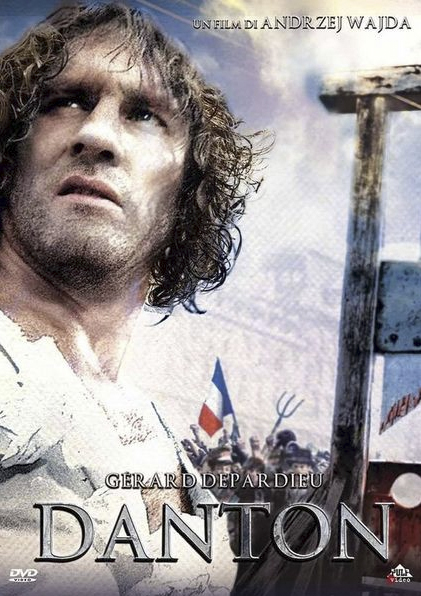
Danton (1983)
Directed By: Andrzej Wajda
Written By: Jean-Claude Carriére
Starring: Gérard Depardieu, Wojciech Pszoniak, Patrice Chéreau, Anne Alvaro
Music: Jean Prodromidés
Brief Description: Gérard Depardieu provides viewers with an excellent portrayal of the French revolutionary Danton. Polish actor Wojciech Pszoniak plays Maximilien Robespierre with perfect acquity.
This French/Polish production, set in the time of the Reign of Terror, specifically depicts the dramatic persecution and prosecution of Danton and his “Indulgent” friends by Maximilien Robespierre (“Maxi” as he is called by his adoring Saint-Just) and the Committees of Public Safety and General Security. Danton and his friends, notably Camille Desmoulins and his wife, want to end the bloodthirsty phase of the Revolution and are prosecuted by the Revolutionary tribunals headed by the sanguinary Fouquier-Tinville.
Danton, along with The Lady and The Duke (listed below) and the older adaptations of A Tale of Two Cities (the earlier 1935 version, produced by David O. Selznick and starring Ronald Colman; and the subsequent 1991 version starring Chris Sarandon and Alice Krige, both tour de force cinematographic adaptations of Charles Dickens’ masterpiece novel) present an instructive, realistic and insightful quadruplet of films on the French Revolution. All four movies are highly recommended.
Rating: 5-star epic existentialist film classic; recommended by MAF.
Theatrical Trailer: https://www.youtube.com/watch?v=zT4e8D80xXI&t=88s
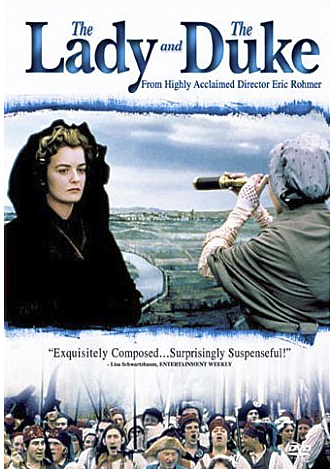
The Lady and the Duke (2001)
Directed By: Éric Rohmer
Starring: Jean-Claude Dreyfus, Lucy Russell, Alain Libolt, Charlotte Véry, Rosette, Leonard Cobiant, Françoise Marthouret
Brief Description: The beautiful Edinburgh-born aristocrat, Grace Elliott, enjoys her comfortable life and continued friendship with her former lover, the Duke of Orleans, until she is caught up in political intrigues following the French Revolution of the early1790s.
The film is a visually opulent, true story based on Elliott’s colorful memoirs of her life in France during those dangerous times. Entertainment Weekly called the movie, “Exquisitely Composed…Surprisingly Suspenseful!”
The film did receive some criticism in France by viewers who disagreed with its uncompromising depiction of the violence of the French Revolution. Some even called it monarchist propaganda. (We must remember they did the same, even banned the monumental book Citizens by Simon Schama). When asked about these criticisms, lead actress Lucy Russell (who plays Grace Elliot) stated: “There does seem to be a great problem, not just in France, but every country has problems facing up to the nasty parts of its history. But there’s a reason it was called “the Terror.” Exactly!
Given the fact the film is based on Elliott’s memoirs, the Duke of Orleans, aka Phillipe Egalité, is seen in a more sympathetic perspective than some viewers, including this reviewer, think he deserves. Jean-Claude Dreyfus, as the Duke, nevertheless, gives an excellent performance. But we marvel at the courage, resilience, and loyalty of the historic Grace Elliott, portrayed so well by Lucy Russell. Her performance will make you stand up and applaud!
Rating: 5-star epic, historic movie recommended by MAF.
Theatrical Trailer: https://www.youtube.com/watch?v=4kppCaZ4r2g

The Plague (1993, Import)
Directed By: Luis Puenzo
Starring: William Hurt, Robert Duvall, Raul Julia, Sandrine Bonnaire
Brief Description: William Hurt plays Dr. Rieux in this cinematographic adaptation of Albert Camus’ existentialist epic novel. And, the performances delivered by Raul Julia and Robert Duvall are spellbinding.
Despite the frequent absurdity of life on this earth, man must do his duty and fulfill his obligation to his fellow man and to the society in which he lives. And, despite the obligatory barbs to Christian theology in general and the personality of the Bishop of Oran in particular, it’s an existentialist gem. And yet, it’s the Christian virtues of charity and hope just beneath the surface that sustain the inhabitants of the city even if some of them don’t recognize it as such.
Arguably, the philosophic and theological undercurrents behind the story’s main plots follow the thoughts of Albert Camus (1913-1960) and Soren Kierkegaard (1813-1855), father of Existentialism, who in part reconciled certain tenets of existentialism and stoicism with Christianity.
I agree with the DVD insert which summarizes the movie as follows:
“Refusing to conceal the outbreak of bubonic plague in Oran, Dr. Rieux sounds the battle cry invoking the government to call in the military and quarantine the city. Joined by a research colleague and two reporters, Dr. Rieux sets up an emergency facility which becomes the heart and hope of a city slowly suffocating. Escape is uncertain; survival of Oran rests on the determination of its citizens to find the solution together.
“An epic story of courage and personal sacrifice set amid the turbulence and disorder of modern day South America. “
Unlike the setting of Camus’ great novel which takes place in Algeria, North Africa, this adaptation is set in a nondescript South American country (Argentina).
Toward the end of his life, Albert Camus refused to sell out existentialism for socialism, or subjugate the metaphysical one to the political other, as was the case with Jean Paul Sartre. Camus’ untimely death in a 1960 automobile accident was tragic for literature and philosophy in general and metaphysics and existentialism in particular.
The novel and movie both stress the nature and existence of free will, even if we make no palpable impact in the greater nature of things; and that citizens should lead good lives, in spite of loneliness, despair, and the tragic tribulations of life on this planet — and sometimes the absurdity of it all!
I do not presume to argue that my philosophic interpretation of The Plague is the only valid one, but only one of many. You will need to do your own research. We do know that Camus rejected all philosophic labels during his lifetime. He did not even called himself an existentialist, and resented his being linked in any way with the political philosophy of Jean Paul Sartre. In his later life, he rejected nihilism, Marxism, and totalitarianism in any of its forms, and firmly denounced the Soviet Red Army crushing of the Hungarian Revolution of 1956. He also spoke firmly against the police state repression and suppression of freedom of the Russian people by the Total State of the USSR.
This movie is not for everyone and a bit of understanding of existentialist philosophy, human psychology, and the Oath of Hippocrates (taken by physicians) may be the key to understanding the deeper layers of this magnificent film classic.
Rating: 5-star epic existentialist film classic; recommended by MAF.
Theatrical Trailer: http://www.youtube.com/watch?v=MGZIUhbzlxo
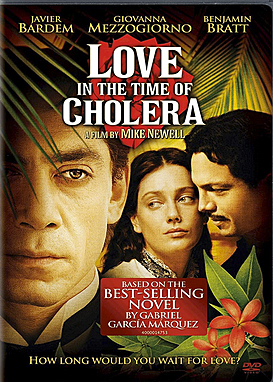
Love in the Time of Cholera (2007)
Directed By: Mike Newell
Starring: Javier Bardem, Giovanna Mezzogiorno, Benjamin Bratt
Brief Description: A beautiful film, a captivating story of romantic love that captures faithfully the spirit of the time. Based on the best selling novel by the Nobel-Prize-winning author Gabriel García Márquez’s, the film is set in the lush tropics of South America at the turn of the 20th century.
The cover of the DVD reads: “… An innocent desire blossoms into a romance for the ages when a youthful romantic Florentino Ariza spots the stunning and sheltered Fermina Daza and immediately falls in love. Denied by her father, Florentino refuses to give up his dream of winning her hand…even if that means waiting decades to fill the passion in his heart.” This is an accurate portrayal of the nostalgic film. We are gratified that García Márquez’s overt lef-wing politics that go as far as supporting the totalitarian policies of the Castro brothers in Cuba do not immerse themselves in this hypnotic film epic, which is wisely devoid of political overtones. The romantic plot and deeply human characters in the novel are artistically and masterfully translated into this spellbinding film flawlessly with a full complement of Latin-American colors and flavors. I ardently recommend this film to art lovers, romantic dreamers, and all students of Latin American culture, particularly literature, drama, and the pursuit of love.
Rating: 5-star romantic film recommended by MAF.
Theatrical Trailer: http://www.youtube.com/watch?v=KkDpvgncboQ
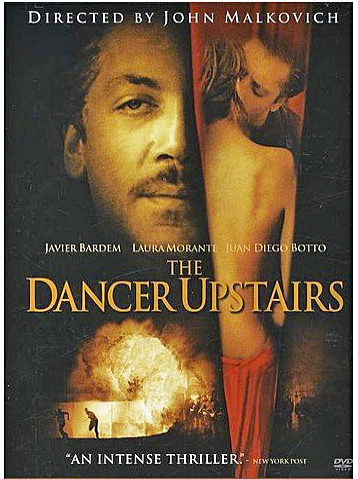
The Dancer Upstairs (2002)
Directed By: John Malkovich
Produced By: Andres Vicente Gomez, John Malkovich
Written By: Nicholas Shakespeare
Music By: Alberto Iglesias, Madredeus
Starring: Javier Bardem, Juan Diego Botto, Laura Morante, Elvira Mínguez, Wolframio Sinué
Brief Description: This magnificent film, starring the Spanish actor Javier Bardem, is simply an unexpectedly enchanting odyssey in cinema — despite the ever looming threat of violence in the revolutionary background of Latin America. This a tour de force performance, both for Bardem, as the main protagonist, and John Malkovich for his impressive directorial debut. What a marvelous accomplishment for them both! The film is carefully sculpted from the novel of the same name by Nicholas Shakespeare, a British writer caught up in Peru at the time of the explosion of terrorism and violence brought about by the Shining Path guerrillas in the 1980s. Shakespeare not only lived through the madness but also actively sought out the guerrillas to understand their aims. Well deserving of his labors, he ended up writing the historic novel on his perilous experience, as well as penning the screenplay for this suspenseful movie. All of this is explained in the extra documentaries in the DVD. And this background documentary material is most welcomed by an audience! John Malkovich and Javier Bardem are also interviewed and give informative accounts of the making of the film and the history behind it.
The film is based on the sanguinary career of “Comrade Gonzalo,” the terrorist Professor of Philosophy, Abimael Guzman, who formed and led the Shining Path (Sendero Luminosa) Maoist guerrilla movement, one of the most notoriously violent terrorist groups ever to seek revolution through anarchy and terror in Latin American history. The Shining Path indiscriminately assassinated public officials, as well as murdered civilians in towns and native Peruvian Indians in rural areas. These poor indigenous peasants living and working in remote areas only desired to be left alone in peace to till the soil and harvest their fields, refusing only to join Gonzalo’s (in the movie he is called “El Presidente Ezequiel”) band of terrorists. Their aim was incite violent revolution and achieve communism in the style of Mao Tse-tung, and they came close to winning — that is until President Alberto Fujimori (who is not in the film) empowered the military and appointed an investigative task force that sought and eventually found Gonzalo. The terrorist was hiding in the upstairs apartment of a quiet dance teacher (who in real life was a ballet dancer and communist agent trained in Cuba). The lawyer-turned policeman, Agustin Rejas (played by Bardem), honest and totally devoted to his task, doggedly pursuits Ezequiel but then falls in love with the dancer. He is torn between his duty to his country and his secret love for the ballet dancer he insists and wants to believe is innocent. The movie even recreates the famous photograph of Abimael Guzman after his capture in his striped black and white prisoner’s uniform secured in a cage suspended by a crane — a wild pathological man being presented to the public and the media presumably in anticipation for his voyage to a maximum security prison (Sept. 24, 1992).
This movie is not a fast paced thriller, as American audiences are wont to watch, but a thoughtfully artistic film, thoroughly suspenseful in its own intrinsic pace, a pace carefully crafted by Malkovich to be savored slowly with gusto and finesse to the very end. This film is highly recommended as the masterpiece of cinema.
Rating: 5-star romantic drama recommended by MAF.
Theatrical Trailer: https://www.youtube.com/watch?v=hyHE9O60cQE

Before Night Falls (2000)
Directed By: Julian Schnabel
Written By: Cunningham O’Keefe, Lázaro Gómez Carriles
Based on the novel by: Reinaldo Arenas
Starring: Javier Bardem, Johnny Depp, Olatz López Garmendia, Sean Penn
Brief Description: Javier Bardem, the Spanish actor (partly of Cuban descent), was an Oscar nominee for “Best Actor” for this universally acclaimed film of 2000. The movie is based on the life of the dissident Cuban poet Reinaldo Arenas, who was arrested and persecuted for engaging in a sex crime he did not commit. The source and inspiration for this movie are the poet’s own memoirs published in 1994 under the same name as the film. Arenas was victimized in Kafkaesque fashion and persecuted for being gay and having the gumption to protest against the dictatorship and censorship in communist Cuba. Arenas finally fled Cuba during the turbulent Mariel boatlift exodus of 1980, reaching the U.S. In American freedom, he continued his writings and work, pleading for freedom and liberty of expression in Cuba. Incredibly, in New York City, where he settled, Arenas was not supported in his work by the powerful American gay lobby, which chose to ignore his work so as not to offend the Castro brothers.
The film is an inspirational and artful masterpiece of cinema and deserves all the acclaim and plaudits it received. Javier Bardem is finally being recognized as one of the greatest actors of this age and his performance here is as unforgettable as those subsequently dramatized in his films “The Dancer Upstairs” (2002) and “Love in the Time of the Cholera” (2007). I cannot possibly recommend this film with more avidity and enthusiasm. Rent the movie or better buy the DVD, for as a discerning viewer you are more apt to watch it more than once!
Rating: 5-star drama recommended by MAF.
Theatrical Trailer: https://www.youtube.com/watch?v=ljcLwaXvwNM
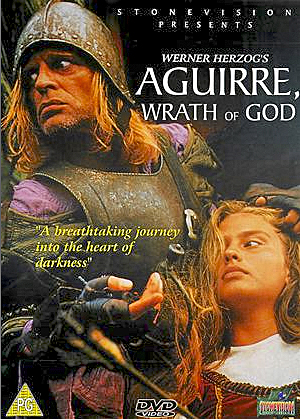
Aguirre, the Wrath of God (1972)
Directed By: Werner Herzog
Produced By: Werner Herzog, Daniel Camino, Hans Prescher, Lucki Stipetic
Starring: Klaus Kinski, Ruy Guerra, Helena Rojo, Del Negro, Peter Berling
Music: Popol Vuh
Brief Description: This is a great epic movie supposedly based on an expedition down the Amazon River in search for El Dorado, the city of gold. The journey down the perilous river surrounded by lush vegetation and the savage and precipitous jungle began with the great Conquistador Gonzalo Pizarro (1502-1548) and ended with the Basque madman, Conquistador Lope de Aguirre (1510-1561; played by Klaus Kinski). The fictitious movie plot is ostensibly based on the surviving diary of the duplicitous and hypocritical Dominican friar, Gaspar de Carvajal.
To become the leader of the vanguard expedition searching for gold, riches, and power, the treacherous adventurer, Lope de Aguirre, had his immediate superiors Pedro de Ursua (1526-1561) and Fernando de Guzman killed. He even defies Philip II, the King of Spain. But it is important to separate what is fiction and what is history in this cinematographic spectacle and surreal adventure — the ultimate tale of intrigue, betrayal and madness!
The historic Gaspar de Carvajal (1500-1584) was a Spanish Dominican friar who accompanied Captain Francisco de Orellana (1511-1546) in the historic expedition and discovery of the Amazon River course and estuary. The real Carvajal had settled in Peru and dedicated himself to the conversion of the Indians. His general attitude towards the Indians was consistent with the benevolence of his better known brother Dominican friar, Bartolome de las Casas. Interestingly, Friar Carvajal was born in and came from Trujillo, Extremadura, Spain, the same hard region and city as that of the conquistadors, the Pizarro brothers and Francisco de Orellana.
In 1540, the historic Friar Carvajal joined Gonzalo Pizarro, governor of Quito (so appointed after the conquest of Peru and the Incas), in an expedition to find the “Land of Cinnamon” in eastern Peru. The expedition consisted of 200 conquistadores and 4000 Indians. It crossed the Andes mountains and traversed the Amazonian jungle under trying and desperate conditions. They were treading inhospitable jungle, and they carried insufficient provisions. All the indians, serving as servants or slaves, reportedly died in the expedition, and Governor Gonzalo himself barely survived with a handful of his men. The ultimate goal of the ill-fated expedition was the search of the elusive city of gold, El Dorado, which was never found.
In the historic epic saga, Francisco de Orellana, Gonzalo Pizarro’s second in Command, asked to lead a search party down the Napo River (a tributary of the Amazon) to find provisions with 64 men. The mission was approved, and Orellana went down the rivers in rapidly constructed rafts (as in the movie). They reached a great confluence of the rivers, but he was unable to return due to the strong current, so the party continued down the Amazon river until it reached its estuary in the Atlantic in 1542. Orellana and his men agonized over this turn of events, just as Ursua and Guzman did in the movie version with Lope de Aguirre. They suspected Gonzalo would call them traitors (which the great conquistador did but died before he could press charges in the court of Spain). In their journey, they actually found many populated, peaceful indigenous trading centers along the river, but the survivors were not fully believed. Orellana made it to Spain, was allowed to return, and died lost in the jungle in a subsequent expedition (1546).
Friar Carvajal was one of the survivors of the first, historic Orellana expedition, and it is from his narrative — which was later published as, “Account of the recent discovery of the famous Grand river which was discovered by great good fortune by Captain Francisco de Orellana” — that we know of the details and travails of the expedition. Recent ethnographic and archeological research has judged the narrative to have been extremely accurate. But this is not the narrative of the expedition of Lope de Aguirre depicted in the movie.
In Werner Herzog’s epic movie, Aguirre, the Wrath of God (1972) — the account of Gaspar de Carvajal which took place in Orellana’s expedition is mixed with the mad journey of Lope de Aguirre down the Amazon river, which took place almost twenty years later in 1561. Lope de Aguirre, actually led 186 conquistadors down the Orinoco and Amazon Rivers, pillaging and plundering as he went. He is reputed to have proclaimed: “I am the Wrath of God, Lord of Tierra Firme and the Provinces of Chile.” Aguirre, just as in the movie, did become the leader of an expedition and subsequent colonization of an island off Venezuela, and he did have his immediate superiors Pedro de Ursua (1526-1561) and Fernando de Guzman killed. He even defied Philip II, the King of Spain. But the real Aguirre was executed in Venezuela after his rebellion against the Spanish Crown had been suppressed. His body was quartered and scattered throughout Venezuela as a traitor.
I will not tell you how the fictitious Aguirre fares in the movie, nor how the expedition ends in the film. Suffice to say, it is an epic movie of surreal, cinematographic wonders; incredible jungle, river, and mountain scenes; and unspeakable betrayal. This epic movie by the master German film director, Werner Herzog, is definitely worth seeing and well deserves a 5-star rating. It is indeed a stunning, hypnotic masterpiece!
Rating: 5-star epic, drama and historic movie recommended by MAF.
Theatrical Trailer: https://www.youtube.com/watch?v=eJDuicFyJPg
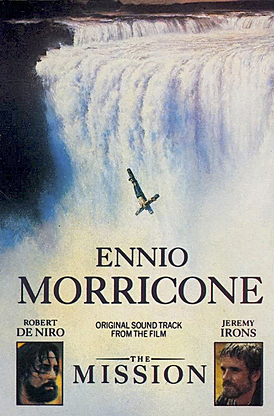
The Mission (1986)
Directed By: Roland Joffé
Produced By: Fernando Chia, David Puttnam
Starring: Robert De Niro, Jeremy Irons
Music: Ennio Morricone
Brief Description: The Mission is a superb film, both cinematographically (i.e., the marvelous jungle, river, waterfalls, and Jesuit mission scenes) and the choral and musical ensemble (by Ennio Morricone), as well as the plot itself based on historical facts. Robert De Niro gives a magnificent performance as the malevolent Captain Mendoza, the slave trader who, in atoning for the murder of his younger brother in a love triangle, becomes a Jesuit apprentice and benevolent defender of the Guaraní Indians — a tribe suddenly threatened with enslavement or extermination by a shift in European policy.
Jeremy Irons is the courageous Jesuit monk, Father Gabriel, who converts and educates the Guaraní Indian tribe above the Iguazu Falls and heads the San Carlos Mission in the jungle bordering Paraguay, Argentina, and Brazil. Ray McAnally renders an incredible performance as the pragmatic ex-Jesuit Cardinal Altamirano, who as Papal envoy is supposedly sent to decide the fate of these Jesuit missions. However, Cardinal Altamirano is only too aware that the fate of the Jesuit missions had already been decided by the secular European powers of Spain and Portugal. In order to increase their power at the expense of the papacy, Spain and Portugal manipulates the hapless Pope Clement III (1758-1769) and forces him to accede to their demands— curtailing the power of the Jesuits in their respective countries (1755-1758). The Jesuits in South America had been protecting and preventing the enslavement of the Guaraní Indians, converting them to Christianity in the Catholic missions, educating and artfully teaching them to produce marketable goods, such as musical instruments, thereby competing with European products.
Without revealing the denouement, here is the gist of how Wikipedia summarizes the events leading to the showdown in the film:
“The Jesuit missions were safe because they were protected under Spanish law. The Treaty of Madrid (1750) reapportioned South American land the Jesuit missions were located on, transferring the area to the Portuguese who allowed slavery. The Portuguese colonials seek to enslave the natives, and as the independent Jesuit missions might impede this, Papal emissary Cardinal Altamirano (Ray McAnally), a former Jesuit priest himself, is sent from the Vatican to survey the missions and decide which, if any, should be allowed to remain.
“Under pressure from both [the Spanish Governor Don] Cabeza and Portuguese Governor Don Hontar (Ronald Pickup), Cardinal Altamirano is forced to choose between two evils. If he rules in favour of the colonists, the indigenous peoples will become enslaved; if he rules in favour of the missions, the entire Jesuit Order may be condemned by the Portuguese and the European Catholic Church could fracture. Altamirano visits the missions and is amazed at their industry and success, both in converting the Indians and, in some cases, economically.”
What follows is not part of the movie but is the background material for what is really happening behind the film’s plot and its dramatic conclusion (which I will not reveal to the reader!). The courts of Europe, in particular the Bourbon monarchs of France and Spain and the weak king of Portugal, manipulated by his prime minister, want to enlarge their power and wealth at the expense of the Catholic Church. Justified and empowered by the secular philosophy of the Enlightenment and the philosophes, particularly Voltaire (and Jean Jacques Rousseau), they have decided that the power of the Jesuits must be eliminated. The Society of Jesus, aka the Jesuits, founded by Ignacio Loyola had served as the reforming arm of the Catholic Church after the Reformation. They have served as the foot soldiers of the Pope, as effective educators, courageous missionaries, and learned theologians. But they are resented by the monarchs of France, Spain, and Portugal for their effectiveness as well as the loyalty to the pope instead of to national governments. In the Jesuit controversy of 1754-59, the Guaraní missions, far in the jungles of South America, provide yet another excuse to attack the Jesuits. At the head of the secular powers is the strongman of Portugal, the guile Marques de Pombal (Prime minister, 1756-77); in Spain, King Charles III (1759-88); In France, the Jansenists, rivals to the Jesuits and influencing the provincial Parlements forced Louis XV to suppress the Jesuits in exchange for the state expropriation of their property. The Jesuits were expelled from Portugal by the Marques de Pombal in 1759; by the Parlement of France in 1764; by the “enlightened despot” of Spain, Bourbon King Charles III in 1767; even by the Hapsburg Austrians in 1770. Pope Clement XiV (1769-1774) in 1773 finally disbanded the order. Frederick the Great of Prussia and Catherine the Great took advantage of this diaspora to bring into Prussia and Russia former Jesuits who became leading educators there. The story is told briefly in Triumph — The Power and the Glory of the Catholic Church by H.W. Crocker III, p. 336-341. Incidentally, the Jesuits were restored by Pope Pius VII after the fall of Napoleon in 1814.
As for the movie, it all takes place in the jungles of South America. I will let the viewers watch and see for themselves how events unfold in this historical thriller and epic film. There is some violence as the drama unfolds but it’s otherwise a decent and educational movie, unlike most of what comes out of Hollywood today! In conclusion, the movie is magnificent and categorically and without reservations highly recommended.
Rating: 5-star epic, drama and historic movie recommended by MAF.
Theatrical Trailer: https://www.youtube.com/watch?v=HU14R9hbUFc
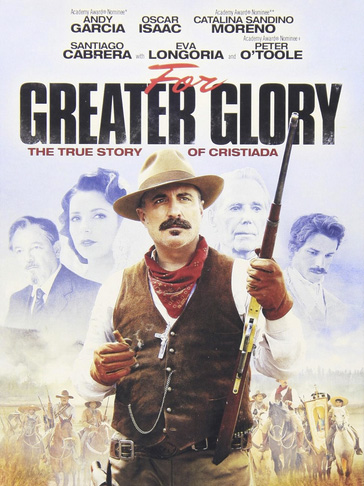
For Greater Glory: The True Story of Cristiada (2012)
Directed By: Dean Wright
Produced By: Fernando Chia, David Puttnam
Starring: Peter O’Toole, Andy Garcia, Eva Longoria, Santiago Cabrera, Rubén Blades
Run Time: 2 hours and 30 minutes
Brief Description: According to Wikipedia: “The Cristero War (La Guerra Cristera), also known as the Cristero Rebellion or La Cristiada, was a widespread struggle in central and western Mexico from 1 August 1926 to 21 June 1929 in response to the implementation of secularist and anticlerical articles of the 1917 Revolution. The rebellion was instigated as a response to an executive decree by Mexican President Plutarco Elias Calles to strictly enforce Article 130 of the Constitution, a decision known as Calles Laws. President Calles sought to limit the power of the Catholic Church in Mexico, its affiliated organizations and to suppress popular religiosity. The rural uprising in north-central Mexico was tacitly supported by the Church hierarchy, and was aided by urban Catholic supporters. The Mexican Army received support from the United States. American Ambassador Dwight Morrow brokered negotiations between the Calles government and the Church. The government made some concessions, the Church withdrew its support for the Cristero fighters, and the conflict ended in 1929. The rebellion has been variously interpreted as a major event in the struggle between church and state that dates back to the 19th century with the War of Reform as the last major peasant uprising in Mexico after the end of the military phase of the Mexican Revolution in 1920, and as a counter-revolutionary uprising by prosperous peasants and urban elites against the revolution’s rural and agrarian reforms.”
Wikipedia uses bland language especially in dealing with Calles and his government to describe the tragedy; otherwise, it is mostly accurate. I have traveled extensively in Mexico and I’m very familiar with its history. Yet I learned a lot from this movie about attitudes, indefatigable courage, and the factual history conveyed in this film—namely, the implacable and intolerant Mexican government waging war against the Catholic Church and its adherents.
The movie is sad but at the same time the documented chronicle of indefatigable courage against all odds is refreshing. The film reveals the little known and hidden history of the Mexico Cristero War of the late 1920s with a very human touch. The rebellion was forced upon the devout Mexican Catholics by the intolerant policies and savage war launched by the tyrannical and brutal government of atheist President Plutarco Elias Calles. For Greater Glory is a magnificent film. In some ways, its historic information is as important to Latin American and 20th century history as the film content of Day of the Siege is to Western Civilization and the 17th and 18th centuries.
In 2000, Pope John Paul II canonized a group of 25 martyrs who were brutally killed by the savagery of the Mexican government during the Cristero War. In 2005, Pope Benedict XVI recognized 13 additional victims as martyrs, preparing their way for their beatification. This group included the heroic 14-year-old José Sanchez del Rio depicted poignantly in the film. —Dr. Miguel A. Faria
Rating: 5-star epic, drama and historic movie recommended by MAF.
Theatrical Trailer: https://www.youtube.com/watch?v=9QUb_StcVzg

Dr. Zhivago (1965)
Directed By: David Lean
Starring: Omar Sharif, Julie Christie, Geraldine Chaplin, Rod Steiger, Alec Guinness, Ralph Richardson, Tom Courtenay
Music: Maurice Jarre
Brief Description: Boris L. Pasternak (1890-1960) won the Nobel Prize in Literature in 1958, one year after his magnum opus, Doctor Zhivago, had been smuggled out of Russia and published in Milan. Set during the turbulent time of the Russian Revolution, the novel had been banned in the USSR. Persecuted by the KGB, the apparachiks of the Soviet Communist party and the Union of Soviet writers (controlled by both the KGB and the Party), Pasternak “reluctantly” declined the Nobel Prize. Prior to that in 1953, when Stalin died suddenly and while the Russians were grieving and mourning the brutal dictator, Pasternak had written, “Men who are not free… always idealize their bondage.” Unlike Russian author, Aleksandr Solzhenitsyn, Pasternak did not possess the psychological fiber to oppose the Soviet authorities. Nevertheless, his novel and his persecution shook the foundations of the Soviet police state under the regimes of Khrushchev and Brezhnev.
The movie, based on Pasternak’s novel, tells the story of a Russian doctor and poet, Yuri Zhivago (played by Omar Sharif), who gets trapped in the savagery of the Bolshevik Revolution and the ensuing Russian civil war between the Soviet Reds and the anti-communist Whites. Although the novel’s protagonist is already married to Tonya Gromeko (played by Geraldine Chaplin), Yuri falls in love with Lara Antipova, a revolutionary’s wife (played by Julie Christie). They suffer untold hardships and privations.
The movie’s musical score by Maurice Jarre is simply magical, and the beauty of the scenery and cinematography are outstanding!
Here is how one Amazon reviewer described it: “David Lean’s ‘Doctor Zhivago’ is a classic film, one that will live on … There are scenes in this movie that will become indelibly etched in the viewers imagination: The opening funeral march through the vast Siberian landscape; the grandeur of the Czarist Russian palaces; the march of the revolutionaries through the Moscow boulevards; the train ride straight out of Dante’s Inferno; the Ice-covered interior of the Zhivago country estate (a truly magical moment in the film)…”
I agree heartedly!
According to Wikipedia, after publication of the Pasternak’s novel in the West:
“…Acting on direct orders from the Politburo, the KGB surrounded Pasternak’s dacha in Peredelkino. Pasternak was not only threatened with arrest, but the KGB also vowed to send his beloved Olia back to the GULAG. It was further hinted that if Pasternak traveled to Stockholm to collect his Nobel Medal, he would be refused re-entry to the Soviet Union. As a result, Pasternak sent a second telegram to the Nobel Committee:
‘In view of the meaning given the award by the society in which I live, I must renounce this undeserved distinction which has been conferred on me. Please do not take my voluntary renunciation amiss.’
“The Swedish Academy announced: ‘This refusal, of course, in no way alters the validity of the award. There remains only for the Academy, however, to announce with regret that the presentation of the Prize cannot take place.’
“Despite his decision to decline the award, the Soviet Union of Writers continued to denounce Pasternak in the Soviet press. Furthermore, he was threatened at the very least with formal exile to the West. In response, Pasternak wrote directly to Soviet Premier Nikita Khrushchev, ‘Leaving the motherland will equal death for me. I am tied to Russia by birth, by life and work.’ As a result of this and the intercession of Indian Prime Minister Jawaharlal Nehru, Pasternak was not expelled from his homeland.”
Rating: 5-star epic, drama, romance, war film movie recommended by MAF.
Theatrical Trailer: http://www.youtube.com/watch?v=wAWrXTn5Wwwhttp://web.archive.org/web/20210218182641/http://www.youtube.com/watch?v=MGZIUhbzlxo
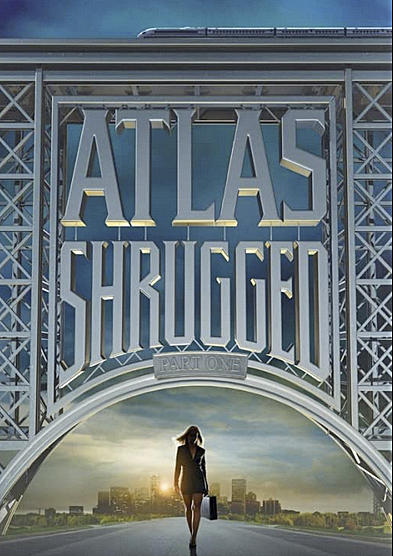
Atlas Shrugged, Part I (2011)
Produced By: Harmon Kaslow, John Aglialoro
Starring: Taylor Shilling, Grant Bowler, Matthew Marsden, Edi Gathegi
Music By: Elia Cmiral
Based on the Novel By: Ayn Rand
Brief Description: Fantastic movie about dangerous times with intriguing parallels to today! This movie is plainly magnificent, the cinematography, the script, the acting all superb! Normally, when I watch a movie based on a great book or novel, the question always arises, how does it compare to the book?
The book, Atlas Shrugged, is fantastic, but may be a bit too long toward the end, particularly for an impatient younger generation. The repeated question of “Who is John Galt?” becomes a bit old in the book, but not so in the movie. So the answer — as far as Part 1 concerns us — is the movie thus far. Why? The writing and the plot for both the book and the movie are a tour de force, but the movie moves at a faster pace than the novel, and the actors, who match the novel’s characters so well, “live and in color” on the screen — may just tilt the balance!
The movie, like the novel, is a cliffhanger of intrigue and suspense, and leaves the viewer wanting more! Moreover, the casting is outstanding. Taylor Schilling and Grant Bowler give magnificent performances as Dagny Taggart and Hank Rearden, and so does the rest of the cast in their respective roles. When Ayn Rand was alive her first pick to play Dagny Taggart was Farrah Fawcett in the 1970s, when Farrah was at her peak, but I don’t see how the casting of the equally beautiful Taylor Schilling could be improved upon!
And the parallels with the present could not have been better chosen by Fate. The movie takes place in 2016, and America is teetering on the abyss of economic disaster, oil prices climbing out of sight, government collusion with businesses (that are cooperating with the increasingly socialistic American state) is rampant, regulations are mounting, economic freedom is being curtailed, individual liberty itself hangs in the balance. The most productive citizens are disappearing from society, while those who are dependent on the state are multiplying…the country is on the verge of revolution. Everything depends on our rugged individualist heroes, Dagny Taggart and Hank Rearden (and their Objectivist philosophy), but they are yet to find out “Who is John Galt?” I give thumbs up to this magnificent movie, and cannot wait for the release of Part II in theaters in the Fall of 2012!
Rating: 5-star movie based on a 20th century objectivist masterpiece; recommended by MAF.
Theatrical Trailer: http://www.youtube.com/watch?v=6W07bFa4TzM

Atlas Shrugged, Part II (2013)
Produced By: Ben ‘Bud’ Brigham, Bernie Laramie, Bruce McNall
Starring: Samatha Mathis, Jason Beghe, Esai Morales, Patrick Fabian, Kim Rhodes
Based on the Novel By: Ayn Rand
Brief Description: Eerily familiar, yet entertaining and powerful! Once again a masterful performance that almost surpasses Part 1! The adaptation once again is exceptional because the cinematography, script, and acting are superb. This is one of the few times that a Hollywood movie approximates the excellence of a classic!
Eerily, the movie parallels the actual U.S. economic decline and the despair of the middle class, as government regulation and oppression increases proportionally! Government bosses and their minions driven by the politics of envy are ending the free enterprise genius that built this country. Brilliant innovators and industrialists disappear as the economy reaches the brink of collapse!
The liberal critics who controlled the opinion cartel of the popular culture may dislike this movie, but the middle class will applaud this film, as it depicts reality, the increasing tyranny of envious politicians, government suppression of liberty, and the crushing of innovation and individual freedom. All because increasing socialism with the strangulation of the economy in the name of false equality and collectivism.
By the strong reaction of liberals (critics or otherwise, especially those who have not even watched the film), you can judge their panic at the film’s masterful performance and powerful message!
Go and see this precious movie and make sure your friends watch it too! I’m looking forward to Part 3 as well!
Rating: 5-star movie (Part 2 sequel) recommended by MAF.
Theatrical Trailer: http://www.youtube.com/watch?v=5gkLg4buEmw
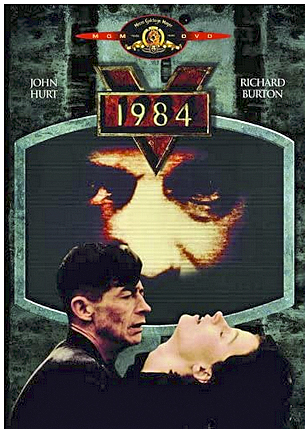
Nineteen Eighty-Four (1984)
Director: Michael Radford
Writers: George Orwell (novel), Michael Radford
Stars: John Hurt, Richard Burton, Suzanna Hamilton, Cyril Cusack
Brief Description: Nineteen Eighty-Four (on-screen title) is a superb and flawless film adaptation of George Orwell’s classic dystopian novel 1984. “Set in a world where absolute conformity in action, word and thought including loyalty to Big Brother is demanded,” the film transports us into a totalitarian future society full of decay and deprivation where the protagonist, Winston Smith, “spends his days working in the Ministry of Truth rewriting history in order to make it fit with present realities” and tries to rebel by falling in love. The movie follows the text closely, a flawless adaptation, and therefore I have provided a link here to what I wrote about the novel in another related article.
This movie was also the last acting role for Richard Burton, who died in August 1984 just two months before the British premiere. The film is dedicated to his memory.
Regarding Orwell’s other celebrated novel, Animal Farm, a 1954 animated adaptation was released. Because the film was animated, it did not have quite the impact as 1984.
Ratings: 5-star drama based on a 20th century masterpiec classic recommended by MAF.
Theatrical Trailer: https://www.youtube.com/watch?v=urrqW4_3IBg

For those of you who like philosophical movies (and I was inspired to post this item) by the eloquent, passionate, and instructive comments by my friend Peter Blindt, who mentioned them in his comment to my article, “Aristotle and the twin legacies: …A Nation dies when the people are taught to hate its own history, heritage, and culture.”
Copenhagen (2002, BBC)
Directed by: Howard Davies
Starring: Daniel Craig, Stephen Rea, Francesca Annis
Brief Description: The film is about the intellectual battle, bitter rivalry, and political falling out between the German physicist Werner Heisenberg (“Uncertainty principle”; played by Daniel Craig) and the Danish physicist and mentor turned rival, Niels Bohr, on the eve of World War II.
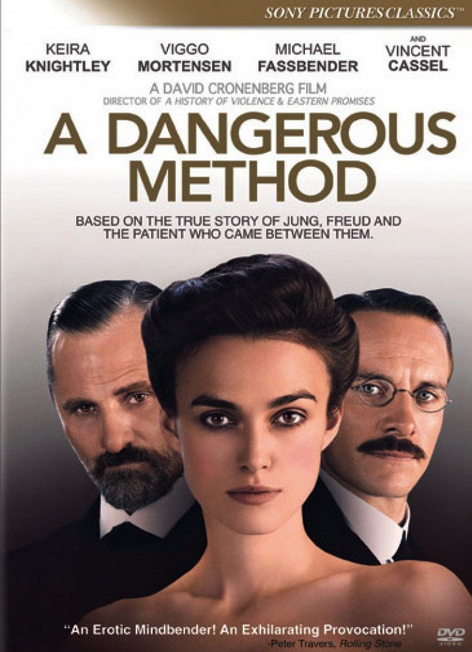
A Dangerous Method (2012)
Directed by: David Cronenberg
Starring: Michael Fassbender, Viggo Mortensen, Keira Knightley
Brief Description: The film is about the friendship and subsequent split between my favorite psychoanalyst Carl Jung, played by the great actor Michael Fassbender, and Sigmund Freud, played by one of my favorite actors, Viggo Mortensen, (a film by also by one of my favorite director/producers, David Cronenberg, who over the years went from a master of “B-horror” movies to a master filmmaker after his association with Viggo Mortensen.
Don’t expect discussions on psychoanalytic theories, mythological themes, the collective unconscious, Jung’s archetypes, but expect drama, forbidden love, sexual transference, and the rivalry between the two master psychiatrists and the ethical dilemmas they must overcome among themselves, their patients, and their female assistants.

The Prisoner (TV Series, 1967-1968)
Creator: Patrick McGoohan
Writers: Patrick McGoohan, David Tomblin
Stars: Patrick McGoohan, Angelo Muscat, Peter Swanwick, Leo McKern
Brief Description: The Prisoner is a magnificent British television series consisting of 17 wonderful episodes broadcast between 1967 and 1968. Patrick McGoohan, who stars in the series was also co-creator. McGoohan developed a-larger-than-life persona with this series, mixing elements of political allegory, science fiction, and psychological thriller. “The series follows a British former secret agent who is abducted and held prisoner in a mysterious coastal village resort where his captors try to find out why he abruptly resigned from his job” is a good description of the beginning. In this role, McGoohan, who is now only referred to as “Number Six,” finds himself a prisoner unable to escape from this incredible village for retired spies and former senior government officials, sundry characters and persons the State wants to keep incommunicado because of their being privy to national security secrets. Rover, a giant white ball, is the automatic guardian so nobody escapes.
Although they live secluded, and supposedly held captives, “The Village” is a virtual paradise in which the denizens live comfortably and are well-cared for. They live in a state-of-the-art surroundings, medical care provided, facilities for active exercises, entertainment, etc. — in short, an exalted life with everything provided for in the “twilight” of their lives.
When I first watched the series in the 1970s, the lack of freedom and vigilance in the village was troubling, and of course I wanted Patrick McGoohan to escape and tell the world the existence of this mysterious place. As McGoohan exclaims at the end of the series Introduction, “I am not a number. I am a free man!” Abstract freedom was everything then, not peace and tranquility!
Now more than 40 years later, as I again watched the series, the question became: Why would anyone want to escape the good and happy life in that quaint and tranquil English village? Nevertheless, even decades later, the magic of the series remains….
At the time of the series, the idyllic place where it was filmed was not revealed, I suppose to keep tourists out. Later, it was revealed the actual “Village” was Portmeirion, Gwynedd, Wales.
Ratings: 5-star TV series recommended by MAF.
Theatrical Trailer: https://www.youtube.com/watch?v=4JrNr85fPms
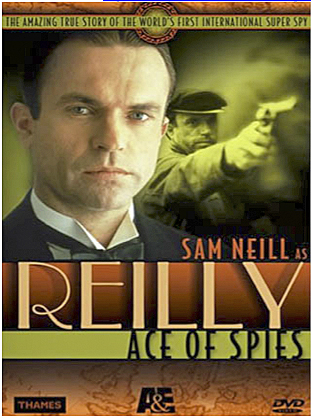
Reilly: Ace of Spies (1983)
Directed By: Jim Goddard, Martin Campbell
Starring: Sam Neill, Jeananne Crowley, Leo McKern, Kenneth Cranham, Michael Bryant, Norman Rodway, Tom Bell, Hugh Fraser
Written By: Troy Kennedy-Martin
Based on the Book By: Robin Bruce Lockhart
Brief Description: From the DVD case: “At the turn of the 20th century, one remarkable man single-handedly tried to alter the course of history. Cold, ruthless, and enigmatic, this Russian-born British agent radically transformed modern espionage techniques and set the mold for a new kind of secret agent — the super spy.
“Reilly: Ace of Spies is the thrilling, suspenseful dramatization of the real-life adventures of Agent ST-1, aka Sidney Reilly, the inspiration behind Ian Fleming’s James Bond. Shot in glorious period detail, one heart-pulsing mission after another captures the arc of Reilly’s brilliant career. From stealing top-secret Russian oil information to a near overthrow of the Bolshevik Revolution to his final capture by Stalin’s forces in 1918, Reilly’s exploits are at times so daring and reckless it’s hard to believe it’s history and not fiction.”
I cannot agree more with this tantalizing synopsis!
British author Robin Bruce Lockhart (born 1920), whose book this miniseries is based upon, was the son of the British diplomat and spymaster, Sir Robert Bruce Lockhart (1887-1970), a personal friend of Sidney Reilly and a participant in some of the intrigues and espionage in the Kremlin during the early days of the Russian Revolution. The British agents, Boris Savinkov, Sidney Reilly and Robert Bruce Lockhart, were trying to get Lenin and the Russian government to renounce the humiliating Russian-German peace Treaty of Brest-Litovsk (March 3, 1918) and entice the Bolsheviks to rejoin the war against Germany. When this did not happen, they were to attempt to overthrow the Bolsheviks!
Robin Bruce Lockhart’s book, Ace of Spies, was published in 1967. The television miniseries “Reilly: Ace of Spies,” written by Troy Kennedy-Martin and starring the New Zealand superstar, Sam Neill, aired in 1983, recounting the British super-spy Sidney Reilly’s saga in graphic, cinematographic detail. Lockhart’s book was then republished in 1984 as Reilly: Ace of Spies.
In 2005, A&E released the miniseries’ 12 original episodes in a 4-disc DVD format (approx. 10 hours, 30 minutes, plus extras). The collector’s set includes a documentary, “Life of Reilly: The Super Spy,” that narrates the true facts of the case and fills in some biographical and historic gaps. For example, what were the real circumstances surrounding Sidney Reilly’s disappearance in Russia in the autumn of 1925, and the extent of his knowledge regarding the Trust organization?
Had Reilly gone to Russia to expose the Trust organization as a “false flag” operation and to avenge his friend Boris Savinkov? Or like Savinkov, had Reilly fallen into an incredibly unsuspecting trap, under the spell and deception of the infamous false “monarchist” Trust operation, which was, in fact, a counter-intelligence organization created by Feliks Dzerzhinsky and the Bolshevik secret police, the Cheka, precisely to lure White Russians and other “enemies of the revolution” back to Russia for their arrest and extermination?
The informative documentary clarifies any discrepancies in the necessarily dramatized and romanticized miniseries, viz-a-viz the harsh realities of what transpired.
The miniseries, “Reilly: Ace of Spies” is a superb historic epic to which I ascribe a 5-star rating for its excellent cinematographic adaptation and dramatization of history, so conveniently accompanied by its concluding documentary, as described.
Rating: 5-star fictionalized history miniseries recommended by MAF.
Theatrical Trailer: https://www.youtube.com/watch?v=ENhwwj-CksQ
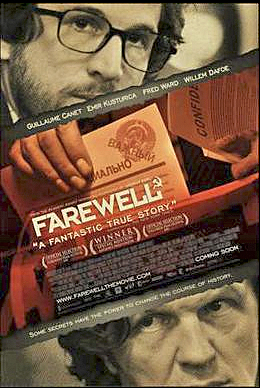
L’affaire Farewell (2009)
Directed By: Christian Carion
Starring: Guillaume Canet, Emir Kusturica, Willem Dafoe, Fred Ward, David Soul
Based on the Book By: Sergei Kostin and Eric Raynaud
Brief Description: The French film, L’affaire Farewell, was made based on the Farewell dossier and released in 2009, the English version in 2010. It has received excellent reviews, featuring Guillaume Canet (playing Patrick Ferrant, as “Pierre Fremont”) and Emir Kusturica (playing Vladimir Vetrov, as “Gregoriev”).
The film avoids making a psychological profile of the hero or interjecting itself in Gregoriev’s mental state and speculating ulterior motives. Gregoriev, correctly, is simply an educated Russian patriot, who fears for the growing might of the Soviet state, feels he has the means to contribute to its destruction, and as a devoted father wants a better future of freedom for his son. The movie recounts the story with dramatic flare and novelistic license, omitting some other details in the interest of time and simplicity, but it nevertheless encapsulates the story well — that is, until the final denouement, where it flaps badly.
In the film Vetrov (Gregoriev) and his son are not close. In reality they were very close. His son Igor, whose real name is Vladik, was privy to Vetrov’s espionage and aware of Gregoriev’s affair with his mistress. Likewise for the sake of family conflict, in the film, Pierre and his wife argue a lot; in fact they collaborated in the espionage for the sake of France, although Pierre’s wife was indeed fearful of getting caught spying in the crutches of a police state like the USSR. Most inexplicably, the film omits the poignant story of how Gregoriev was really caught by the KGB and how his espionage career ended. Instead, the producers sadly chose to use the final moments of the film as left-wing propaganda, a club to beat the United States, suppressing the truth and omitting the most dramatic episode of the Vetrov saga.
The film is well done, and for the most part it encapsulates the substance of the Farewell Dossier, that is, until the end of the movie when truth and content are subordinated to bashing the United States, a totally fabricated ending, in which the CIA (represented in a rare appearance by Willem Dafoe playing the CIA Director), the U.S., and the American President (Fred Ward playing President Ronald Reagan) are slandered and smeared by betraying Farewell! This is a very mendacious ending of U.S. betrayal (with no basis at all in fact) for an otherwise very good film!
Read Dr. Miguel Faria’s review of the book Farewell — The Greatest Spy Story of the Twentieth Century by Sergei Kostin and Eric Raynaud. This book review was also featured at RealClearHistory.com.
Rating: 4 star movie (recommended with caveats) by MAF.
Theatrical Trailer: http://www.youtube.com/watch?v=kKVwoKD-BxA
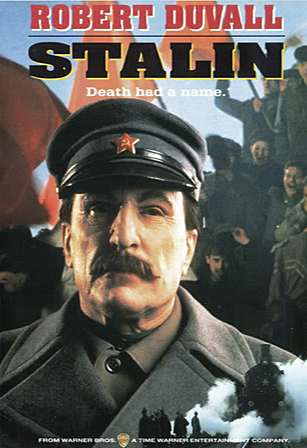
Stalin (1992)
Directed By: Ivan Passer
Produced By: Mark Carliner, Ilene Kahn Power
Starring: Robert Duvall, Julia Ormond, Maximilian Schell, Jeroen Krabbe, Jim Carter
Brief Description: This is an excellent 3 hour television film produced by HBO portraying the unvarnished life of Joseph Stalin, from the October Revolution 1917 and the Soviet takeover of Russia by Lenin’s Bolsheviks up through the time of Stalin’s mysterious death on March 5, 1953. The film has an excellent cast, starring Robert Duvall and Julia Ormond. It is based in part on the memoirs of Stalin’s daughter Svetlana Alliluyeva (1926- 2011), whose writings are read in brief intervals throughout the film, punctuating and reminding us of its non-fictitious nature and the brutality of Stalin’s personal rule. Advisors to this film included the scholars General Dmitri Volkogonov and Robert Conquest. Robert Duvall gives an incredibly credible performance as Stalin and so does Julia Ormond as Nadezhda Alliluyeva. After the tour de force perfomances, it is no wonder the film won three Golden Globe and four Emmy awards.
Rating: 5-stars all around! Recommended by MAF.
Theatrical Trailer: https://www.youtube.com/watch?v=XsURfbwwfWM
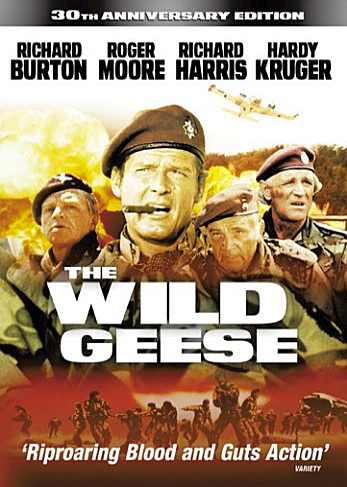
The Wild Geese (1978)
Directed By: Andrew V. McLaglen
Produced By: Euan Lloyd
Starring: Richard Burton, Roger Moore, Richard Harris, Hardy Kruger, Stewart Granger, Winston Ntshona, John Kani, Ian Yule
Based on the Book By: Daniel Carney
Brief Description: This is simply the best mercenary film ever produced, maybe the best movie in this genre that will ever be made!
This epic film is a tour de force, a magnificent blend of sensational cinematography and war adventure (with a tight plot and an incredible cast to boot). It is an action-packed, suspense-thriller from beginning to climactic end. The product teaser on the DVD reads:
“Their home is the battlefield. Their calling is war. Their only loyalty is to each other. They are the Wild Geese, 50 crack mercenary paratroops commanded by fearless veteran Colonel Faulkner (Richard Burton). Their mission: to land in a remote and hostile corner of Africa, free the one man who can change a nation’s destiny, seize the airport, and make their escape… But while the Wild Geese are fighting and dying in the African sun, sinister forces in the corridors of power are working to seal their fate.”
Yes, but there is more to this cinematographic extravaganza. The consultant to this film (technical advisor) was the renowned soldier of fortune, Colonel Michael (“Mad Mike”) Hoare. And the main hero in this movie, Colonel Allen Faulkner, is patterned after Hoare himself. Ian Yule, one of the actors in the movie, was an actual mercenary who served in Africa in the 1960s. Hardy Kruger was a former German POW, who successfully escaped from allied custody and reached Germany, later becoming a successful actor. The character of the good, ailing, long-imprisoned President Limbani is played by the South African playwright, Winston Ntshona, and the role was inspired by Congolese statesman Moise Tsombe, who had died at the hands of his pro-communist captors after sustaining physical torture for years.
Colonel Hoare, the movie’s technical advisor and perhaps the most famous mercenary of all time, had participated in the first Congo Crisis of 1960-61, leading the Commando 4 unit that fought to help the province of Katanga gain her independence from the savagery of the newly independent nation of the Congo.
In 1964, Hoare was formally recruited by President Moise Tsombe to fight the barbaric communist troops, the Simbas. The Colonel later fought with Belgian paratroopers and anti-communist, Cuban exile pilots and commandoes in an attempt to save the lives of 1,600 Europeans and missionaries stranded in the Congo and to rescue them from the savage Simba rebels, who were later supported by communist Cuban troops led by Che Guevara.
So the film’s plot was inspired not only by the Simbas and Congolese wars of the 1960s but by the end of life tragedy of President Moise Tsombe, the freedom fighter, who fought for the liberation of Katanga, trying to free this formerly prosperous province from the dictatorial and brutal rule of the Congo in the 1960s. (An excellent documentary on this episode, “Katanga — The Untold Story (Of U.N. Betrayal)” was produced in VHS format by American Media in 1991.)
The Wild Geese DVD contains other supplementary features, including the Making of the Wild Geese, a commentary with Sir Roger Moore (of James Bond “007” fame), the star-studded Charity Premiere Newsreel, star biographies and interviews, theatrical trailers, interactive combat menu, etc.
The music of the soundtrack, “The Flight of the Wild Geese, ” was written and performed by Joan Amatrading, a black, British singer-songwriter, and she was magnificent!
When first released, this film was a commercial success in Great Britain, but it was judged controversial, and due to Hollywood’s partisan politics as well as distribution problems, it was a flop in the United States. Fortunately since that time, the movie has been resurrected by word of mouth and has developed a life of his own, or so it seems. (Wild Geese II, however, remains a well-deserved flop, a truly boring sequel.)
Rating: 5-star epic adventure loosely based on more recent mercenery and war happenings; recommended by MAF.
Theatrical Trailer: http://www.youtube.com/watch?v=nNef4MC4ldo
Honorable mention should go to perhaps the only “other” movie in this genre worth mentioning:
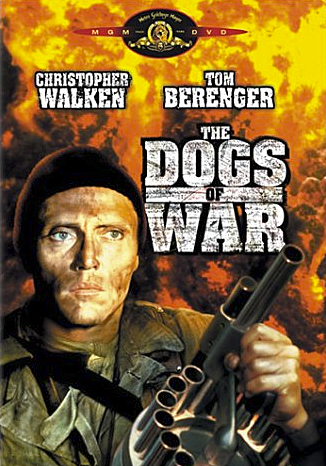
The Dogs of War (1981)
Directed By: John Irvin
Produced By: Norman Jewison, Patrick Palmer
Starring: Christopher Walken, Tom Berenger
Based on the Novel By: Frederick Forsyth
Brief Description: This movie was heavily influenced by The Wild Geese, and interestingly the good African ruler in this movie is again played by the South African playwright, Winston Ntshona, but there the historic comparisons end.
This second movie is purely an entertaining, action-filled adventure. As usual, Christopher Walken, as the protagonist (Jamie Shannnon) in this lesser but still a very good film, played his role magnificently.
Ratings: 4-star action adventure recommended by MAF.
Theatrical Trailer: https://www.youtube.com/watch?v=RFzzpyKdzV4
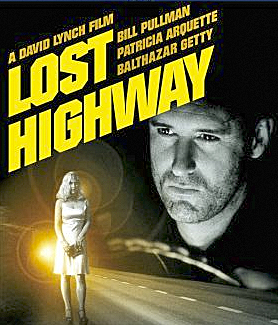
Lost Highway (1997)
Directed By: David Lynch
Starring: Bill Pullman, Patricia Arquette, Balthgazar Getty, Robert Blake, Robert Loggia, Gary Bussey, Natasha Gregson Wagner
Music: Angelo Badalamenti
Brief Description: From the director of “Blue Velvet” and “Twin Peaks,” comes a masterpiece of “haunting sexuality, ricochet action and fleeting, murderous shadows…that begins and ends on the Lost Highway….
“Trapped in their worlds of desire, destiny, and unknown destination, where the truth is always just a short way further down the road,” this all-star cast takes us through a “powerful, sensual and extraordinary movie.”
Horror/deviltry or psychological thriller? Faustian bargain with the Devil gone awry or mental illness and psychogenic fugue? A well-written review was posted on Amazon.com by a David Jamieson in 2000 based on research into David Lynch’s cinematographic background and intentions. I believe this reviewer to be correct, although I still prefer to think that the Devil is in the details!
Rating: 5-star movie recommended by MAF.
Theatrical Trailer: https://www.youtube.com/watch?v=IiMUl8ruWdk
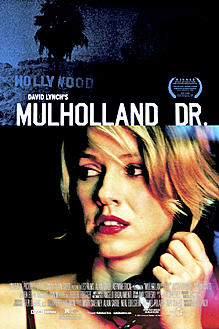
Mulholland Drive (2001)
Directed By: David Lynch
Starring: Naomi Watts, Laura Elena Harring, Justin Theroux, Melissa George, Ann Miller, Lee Grant, Dan Hedaya, Chad Everett, Billy Ray Cyrus
Brief Description: From the director of “Blue Velvet” and “Lost Highway” comes a “sexy thriller, acclaimed as one of the year’s best films. Hypnotic!…Twisting, dangerous and addictive.” Director David Lynch even provides the viewer with “10 clues to unlocking this thriller” on the inside material of the DVD!
In 2000, David Jamieson, a reviewer on Amazon, wrote an excellent review of David Lynch’s masterpiece, and one of my favorite movies of all times, Lost Highway. The review was so well done that a reader asked him to do the same for the subsequent and equally enigmatic film, Mulholland Drive. Another David Lynch unraveller came to the rescue of the many perplexed movie goers at a loss for the meaning of this movie. I include the link of that review by Steve Klemow, who states that his review “is essentially one giant ‘spoiler,’ so if you haven’t seen the film, take heed.” I agree with this marvelous review.
Rating: 4-5-star movie recommended by MAF
Theatrical Trailer: http://www.youtube.com/watch?v=PqxxMljN5_Q
Honorable mention should go to another David Lynch movie:
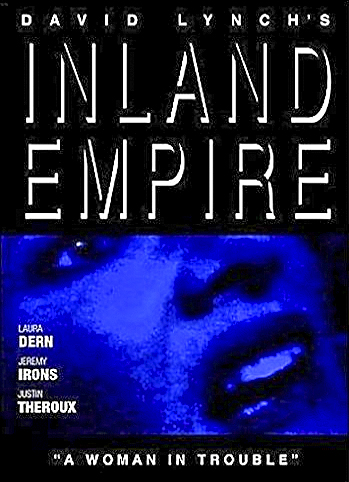
Inland Empire (2006)
Directed By: David Lynch
Starring: Laura Dern, Jeremy Irons, Justin Theroux, Karolina Gruszka, Harry Dean Stanton, Julia Ormond, Diane Ladd, Mary Steenburgen, Nastassja Kinski, Naomi Watts (voice), Laura Elena Harring (voice), David Lynch (voice)
Brief Description: When asked what Inland Empire was about, Director David Lynch described it as “a mystery about a woman in trouble.” The IMDb website sums up the plot this way: “As an actress starts to adopt the persona of her character in a film, her world starts to become nightmarish and surreal.”
Inland Empire also had excellent reviews by two Amazon reviewers (i.e., “Rocky Raccoon” and “Unlucky Frank”), who came up with excellent explanations for the enigmatic happenings in this lesser masterpiece. They relate in their reviews (one with a very descriptive title, “Eternal Recurrence and The Karmic Wheel of Time; June 12, 2009) the influence of Hindu Eastern philosophies on David Lynch, citing the writings of the Vedas and the Upanishads — not to mention the involvement of evil karma — to solve the riddle of the film. Those reviews are cited in the comments below.
I believe these reviews of the films are right on target, interpreting the movie as Champollion deciphered the Rosetta Stone!
Rating: 3-star movie recommended only to Laura Dorn and David Lynch fans and New Agers!
Theatrical Trailer: https://www.youtube.com/watch?v=VpJs5zuxKYI
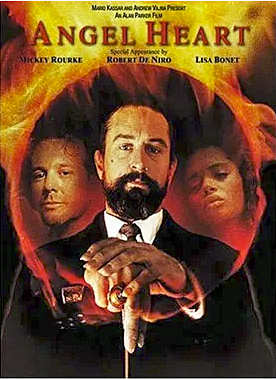
Angel Heart (1987)
Directed By: Alan Parker
Starring: Robert, De Niro, Mickey Rourke, Lisa Bonet, Charlotte Rampling
Music: Trevor Jones
Brief Description: A masterpiece of cinema with various genres interconnected, horror/deviltry intertwined with psychological thriller. But there is also a great dark mystery…
“Harry Angel, a down-and-out fifties, Brooklyn gumshoe takes us on a journey of violence and murder that canvasses the desperate streets of Harlem, smoke-filled jazz clubs of New Orleans, and ultimately to voodoo rituals in the sweltering swamps of Louisiana. Angel Heart is a truly unsettling film experience.”
Horrifying suspense…Robert De Niro and Mickey Rourke at their best.
Rating: 5-star suspense horror movie masterpiece recommended by MAF.
Theatrical Trailer: http://www.youtube.com/watch?v=Vp0LXxkx7yA
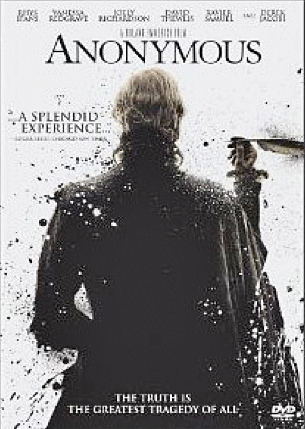
Anonymous (2011)
Directed By: Roland Emmerich
Starring: Rhys Ifans, Vanessa Redgrave, Joely Richardson, Derek Jacobi
Music: Thomas Wander and Harald Kloser
Brief Description: Set in Elizabethan England, Anonymous “speculates on an issue that has for centuries intrigued academics and brilliant minds. Who was the author of the plays credited to William Shakespeare?”
I first learned about this controversy after reading a 1991 article written by essayist and editor Joseph Sobran in National Review. Suddenly many murky questions I had about William Shakespeare became very clear. The real author of his plays, Sobran claimed, was Edward de Vere, 17th Earl of Oxford, a very learned man and a literary scholar but whose authorship of those plays was not acceptable for a man of his rank. Rhys Ifans is magnificent in his role as the Earl of Oxford.
The veracity and revisionism of the Sobran article was answered in a subsequent National Review issue by none other than Charlton Heston, who vigorously defended Shakespeare and the accepted conventional historical account.
The movie is magnificently made, the acting and cast superb, the setting (e.g. the Globe Theater, London circa 1600, etc.) and cinematography outstanding. But the historical additions and elaborations, interwoven with pompous fictional exuberance, detract from the more serious literary debate. I for one was disappointed for example when, as someone else wrote, Queen Elizabeth I was transformed in the film from the austere, dignified Tudor Virgin Queen, who placed the throne and England above everything else, into a young, fluttering nymphomaniac monarch butterfly and later to a befuddled old hag of a queen.
In those days of the Renaissance when monarchs had no real private lives, Queen Elizabeth I could not have been another Catherine the Great without the court and courtiers knowing of her sexual liaisons and gossipy peccadilloes, nor could she have prevented these transgressions from seeping into the fabric of historical accounts.
Likewise, the character of William Shakespeare, the literary wraith, is needlessly distorted beyond belief for the purpose of contrast and the sensationalization of the film.
The elaboration and interweaving of fictitious events leading to the Earl of Oxford as one of the former lovers of the queen and whose sexual consummation led to the bastardy of the Earl of Southampton also adds to our sense of disbelief.
I recommend a little homework for those who seek historical accuracy before watching this movie. Look up the main historical characters and learn a bit about them, i.e., Queen Elizabeth I; the Earls of Essex and Southampton; William Cecil and his son, Robert Cecil; Ben Jonson; and of course the Earl of Oxford and William Shakespeare.
If one watches this movie with a sense for historical accuracy, not to mention if seeking clarification as to the dispute of who actually wrote the Shakespearean plays — the film is disappointing. Admirers of Queen Betsy will be enraged. Ben Jonson fans will be delighted. Those seeking historical entertainment and those who enjoy alternative history for its sake — will be entertained. Those who watch historical films to learn history and use that “history” for conversational purposes will be deceived, and will be unwitting deceivers to others, unless they are careful historical connoisseurs, who can separate very carefully the wheat from the chaff in this fictionalized historical movie!
Rating: 4-star fictionalized historical movie recommended by MAF with the aforementioned caveats.
Theatrical Trailer: http://www.youtube.com/watch?v=YrUUxD1QmaQ
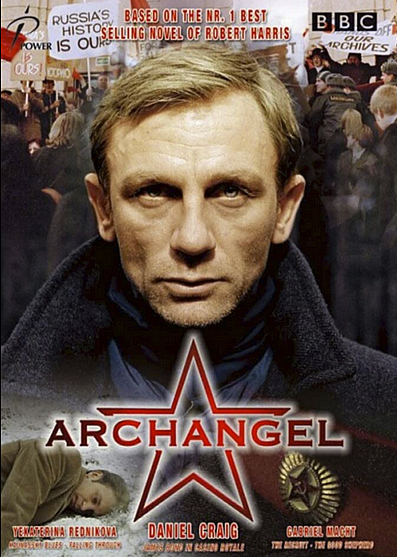
Archangel (2005)
Starring: Daniel Craig, Yekaterina Rednikova, Gabriel Macht, Lev Prygunov
Directed By: Jon Jones
Produced By: Christopher Hall
Music: Rob Lane
Brief Description: Based on the best selling novel by Robert Harris, “Archangel tells the story of four eventful days in the life of Fluke Kelso (Daniel Craig) — a former Oxford historian attending a conference in Moscow on the newly opened Soviet archives. Kelso is about to leave the city when a surprise visit from an ex-officer of the Soviet Secret Police changes his mind…When the man is later found murdered, Kelso seeks out the victim’s estranged daughter…and together they embark on a treacherous quest that leads to the remote Russian seaport of Archangel — where the final secret of Josef Stalin has been hidden for almost half a century!”— reads the DVD cover.
This is an excellent movie because it works on a very plausible scenario in Russian politics today. Millions still love the memory of Stalin, forgetting his brutal reign of terror. The film is spellbinding, and reaches a crescendo unraveling the mystery within an enigma, which traces back to the night of Stalin’s death.
Those who have read my articles on the Russian elections of 2012 and “Stalin’s Mysterious Death” will understand why I love this film.
Rating: 5-star suspense thriller about Stalin and modern Russia recommended by MAF.
Theatrical Trailer (Italian version): http://www.youtube.com/watch?v=EP1p7XuaMJY

The Road Warrior (1981)
Starring: Mel Gibson, Bruce Spence, Michael Preston, Max Phipps
Directed By: George Miller
Produced By: Byron Kennedy
Brief Description: “In the annals of action movies few can compare to The Road Warrior, a full-throttle epic of speed and carnage that rockets you into a dreamlike landscape where the post-nuclear future meets the mythological past. More simply, it’s also one of the most mind-blowing stunt movies ever made. Mel Gibson makes his mark on movie history as Max, the heroic loner who drives the roads of outback Australia in an unending search for gasoline. Arrayed against him and the other scraggly defenders of a fuel-depot encampment are the bizarre warriors commended by The Humungus, notorious for never taking prisoners…When the battle is joined, the results are savage and spectacular” — reads the DVD cover.
This is an excellent film and the movie that made Mel Gibson famous. I have always enjoyed well-written, well-acted, post-apocalyptic movies — usually those gems from the 1950s-1980s such as “5ive” (1951); “Where Have All the People Gone?” (1974) with Peter Graves and Kathleen Quinlan; “Planet of the Apes” (1968); “The Omega Man” (1971) with Charlton Heston; even cheesy movies such as Roger Corman’s “Last Woman on Earth” (1960); and of course, the masterpiece, “Panic in the Year Zero” (1962 ) with Ray Milland.
The Road Warrior is the ultimate post-apocalyptic, fast paced, action packed film that is not only cinematographically enthralling but also suspenseful and mesmerizing, keeping you on the edge of your seat throughout the entire performance.
Rating: 5-star futuristic thriller and Sci fi film recommended by MAF.
Theatrical Trailer: http://www.youtube.com/watch?v=Gdv5EtZQ6jg
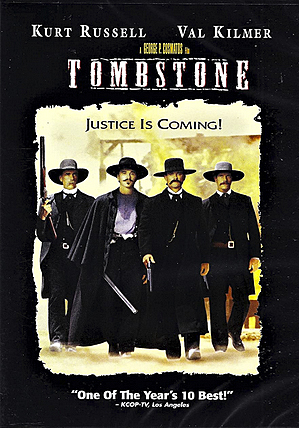
Tombstone (1993)
Directed By: George P. Cosmatos
Written By: Kevin Jarre
Starring: Kurt Russell, Val Kilmer, Sam Elliott, Bill Paxton, Powers Boothe, Michael Biehn, Jason Priestly, Dana Delany, Joanna Pacula, Michael Rooker, Billy Zane, Charlton Heston
Narration By: Robert Mitchum
Music By: Bruce Broughton
Brief Description: All-star western based on events in the 1880s that took place in and around Tombstone, Arizona. Wyatt Earp (Kurt Russell), his brothers Morgan (Bill Paxton) and Virgil (Sam Elliott) Earp, and their friend Doc Holliday (Val Kilmer) have all settled in Tombstone, but trouble soon follows. After they become targets of a cowboy and outlaw gang, the Earp brothers and Doc Holliday join forces to rid the town of the lawless gang once and for all. The famous Gunfight at the O.K. Corral and the Earp Vendetta Ride is portrayed in this film. This is excerpted from the excellent Wikipedia entry. We add that this film is marvelously acted, fabulously written, even if it is not completely historically accurate. It is, in my opinion, the best movie portraying Wyatt Earp, his brothers, Doc Holliday, and the events leading to the Gunfight at the O.K. Corral to date. — MAF
Rating: 5-star movie recommended by MAF.
Theatrical Trailer: https://www.youtube.com/watch?v=QPTVLKKgGXw
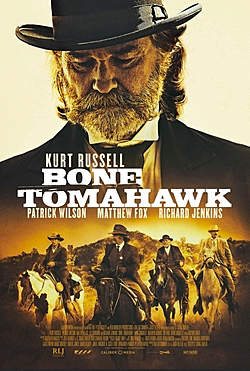
Bone Tomahawk (2015)
Directed By: S. Craig Mahler
Starring: Kurt Russell, Patrick Wilson, Matthew Fox, Richard Jenkins, Lili Simmons, Evan Jonigkeit, David Arquette, Sid Haig
Written By: S. Craig Mahler
Music By: Jeff Herriott, S. Craig Mahler
Brief Description: Western/horror set in the late 1890s. After a band of cannibal savages (cave dwellers or “Troglodytes”) kill a stable boy and kidnap a deputy sheriff and a local woman, who is also the town physician and wife of a young settler from the small town of Bright Hope, four townsmen — led by Sheriff Franklin Hunt (played by Kurt Russell, who gives a stellar performance), along with his aging deputy sheriff (marvelously portrayed by Richard Jenkins); the woman’s husband (Patrick Wilson, giving a fantastic performance); and an Indian-fighter gunslinger (Matthew Fox, in a splendid, sublime performance) — set out to rescue the hostages and return them safely home. However, the cannibalistic enemy, ruthless, muscular brutal fighters and torturers, place the mission and the four townsmen’s survival in serious jeopardy. This action-packed thriller is eloquently written with excellent dialogue, manners, and enchanting conversations among the four friend-protagonists that is rarely found in movies today! Caveat: There is one gory, shocking scene and brutal fighting towards the end of the film. Nevertheless, the movie will keep you on the edge of your seat! — MAF
Rating: 5-star movie recommended by MAF.
Theatrical Trailer: https://www.youtube.com/watch?v=0ZbwtHi-KSE
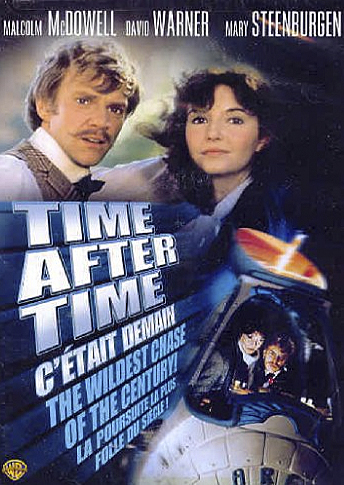
Time After Time (1979)
Starring: Malcolm McDowell, David Warner, Mary Steenburgen
Directed By: Nicolas Meyer
Produced By: Herb Jaffe
Brief Description: “London 1893 is home to a killer with a macabre nickname, Jack the Ripper (David Warner)…and also a visionary genius who would write The Time Machine, H.G. Wells (Malcolm McDowell). But what if H.G. Wells’ invention wasn’t fiction? And what if Jack the Ripper escaped capture, fleeing his own time to take refuge in ours — with Wells himself in pursuit? Time After Time is a marvelous entertainment of shivery suspense and sly social comment” — reads the DVD cover.
This is a fantastic thriller, and those who have viewed the 1960s TV series, “Time Tunnel,” will deem this movie a masterpiece — linking H.G. Well’s story of The Time Machine with the unsolved mystery of London’s serial killer, Jack the Ripper. One of my favorite and memorable scenes from this movie is that of Jack the Ripper (David Warner) sitting on the bed of his present day (1979) San Francisco Hyatt Regency Hotel room asking H.G. Wells (Malcolm McDowell; who has chased Jack the Ripper into the future after his last murder in London) to sit with him and watch the violence depicted on television and telling Wells that the present is his time! There is also romance between H.G. Wells and an irresistible banker (Mary Steenburgen), destined to become his wife, both on and off the screen! A gem of a movie!
Rating: 5-star Sci fi film with Jack the ripper and H.G. Wells recommended by MAF.
Theatrical Trailer: http://www.youtube.com/watch?v=M3c5mCHe5I0
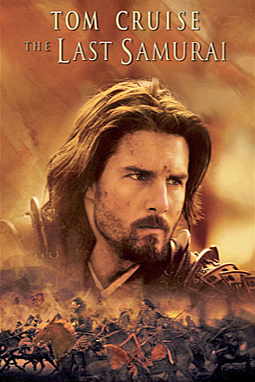
The Last Samurai (2003)
Starring: Tom Cruise, Ken Watanabe,
Timothy Spall, Billy Connolly, Tony Goldwyn, Hiroyuki Sanada, Koyuki
Directed By: Edward Zwick
Produced By: Marshall Herskovitz, Edward Zwick, Tom Cruise, Paula Wagner
Music: Hans Zimmer
Brief Description: The Last Samurai is a 2003 American film starring Tom Cruise and the Japanese actor Ken Watanabe, supported by an excellent cast of American and Japanese actors. The film’s plot is based on the historic 1877 Satsuma Rebellion led by the samurai Saigo Takamori, who was opposed to the forced modernization of Japan under the direction of Western powers hired by the Imperial government.
The film’s initial setting in Japan is Yokohama Harbor, bustling with activity. East and West meet here. Here too lands and enters Nathan Algren, a disillusioned and cynical American Civil War veteran, played by Tom Cruise. He had served the American military as captain of the 7th Cavalry but had been disgraced by being ordered and committing a horrible war crime against Native Americans. As a skilled soldier with a reputation, Algren was hired to train and modernize the Imperial Japanese Army. But after the first battle, Captain Algren is captured by the rebellious samurais and under the influence of the learned and philosophic samurai chief Katsumoto, played by Ken Watanabe, the ex-captain is intrigued by observing the simple samurai way of life that offers him redemption. He joins the rebellion and trains hard to become a samurai. I will not further reveal the plot. The readers can find out for themselves by viewing this incredibly well-produced, directed and acted drama — and a spectacular, epic film. Read Dr. Miguel Faria’s full review of the movie.
Rating: 5-star epic film recommended by MAF.
Theatrical Trailer: https://www.youtube.com/watch?v=qjIdpsu_BMc
Japanese Samurai Cinema
The following films are historic or epic films about the samurai culture of Medieval Japan and are considered 4/5 or 5/5 star ratings. All are highly recommended to the aficionados of the Japanese samurai culture.
1. The Great Bandit, aka and initially released as The Samurai Pirate — Lost World of Sinbad (1963). Director: Senkichi Taniguchi. Actor: Toshiro Mifune. This is a highly entertaining and incredibly well-produced, adventure/fantasy. This is one of several Japanese movies I watched as a youngster in Cuba that left a lasting impression, which did not end until I found the movie and watched it again on DVD 40 years later. It still possessed the childhood magic — utterly fantastic. This film does not have the usual suffering, resignation, and serious stoicism of the earlier samurai movie; it is immerse in fantasy , adventure, and humor. Two scenes are unforgettable: The battle of Toshiro Mifune at the bridge with a warrior with the long gyrating lance, and our hero flying on a kite to rescue the princess in the tower. How I could accoplish this feat myself, as still a younster, was a subject of contemplation. This Saturday afternoon fantasy/adventure was the last of the samurai films I watched as a younster until the 1980s, when I searched for them and watch them as an adult. Watch then with the family and don’t forget the boys!
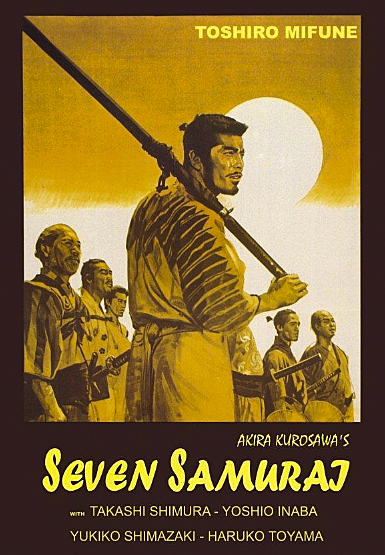
2. The Seven Samurai (1954). This is a three-hour epic masterpiece of Japanese cinema. Akira Kurosawa’s tour de force is a superior Samurai Japanese version to the original Western version created by Hollywood in the The Magnificent Seven. This is an film of duty, courage, and humanity of heroic proportions. A peasant village hires a small group of samurais to defend it from brigands. The story is poignant and the battle scenes are magnificent. It is highly recommended and the necessary introduction to Japanese Samurai cinema.
3. Throne of Blood (1957). Directed by Akira Kurosawa and starring Toshiro Mifune. This is the Japanese version of Macbeth as dramatized by Kurosawa.
4. Hidden Fortress (1958). Directed by Akira Kurosawa and starring Toshiro Mifune. This film is supposedly the inspiration for Star Wars. A general must guard and convey a lively and irrepressible princess to safety.
5. Sanjuro (1962). Directed by Akira Kurosawa. Japanese actor Toshiro Mifune plays a crazy acting and slovenly dressed samurai who comes to the assistance of young warriors fighting a corrupt clan. The last scene of Sanjuro fighting an enemy samurai is spectacularly memorable and short.
6. Yojimbo (1962). Directed by Akira Kurosawa and starring Toshiro Mifune. This is the Japanese version of Sergio Leone’s Fistful of Dollars, as dramatized by Kurosawa. Mifune plays as remarkable a role with his katana as Clint Eastwood did with his colt 45.
7. Harakiri (Seppuku) (1962) Directed by Masaki Kobayashi, and starring Tatsuya Nakadai, the great actor who will reappear twenty years later in Kagemusha and Ran. A poor and unemployed samurai is forced by his lord to commit harakiri in the feudal society of the 17th century Japan. This film leaves a lasting sense of suffering, stoicism, and fatalism in Japanese feudal society. It is another tale of injustice, honor, violence, and death, a film devoid of humor, thoroughly stoic and unforgettable. Not for the squemish.
The next two films represent the magnificent resurgence of the legendary Japanese director Akira Kurosawa:
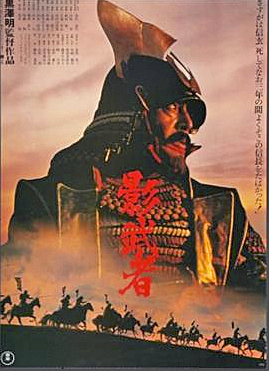
7. Kagemusha, aka The Shadow Warrior (1980). A thief (Tatsuya Nakadai) impersonates the warlord (daimyo) Takeda Shingen, who has recently died of a wound, in order to keep two rival clans, led by Tokugawa Ieyaso and Oda Nobunaga, at bay. The film is inspired by historical events in the great medieval conflict between three rival daimyos fighting for the shogunate of Japan. The film culminates with the 1575 Battle of Nagashino.
8. Ran (1985). Directed by Akira Kurosawa and starring Tatsuya Nakadai. This is the Japanese version of King Lear as envisioned by the legendary Kurosawa. It was also Kurosawa’s last film.
Psychological Thriller
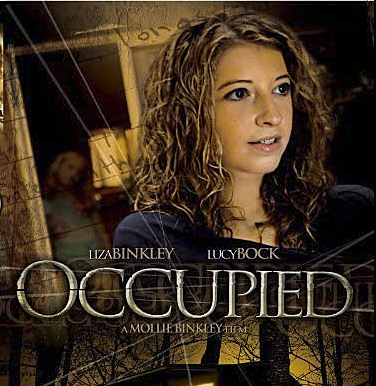
Occupied (2011)
Starring: Liza Binkley, Lucy Bock
Directed by: Mollie Binkley
Written by: Mollie Binkley
Produced by: John Binkley, Oliver Bock
Music by: Simon Charles Katz
Edited by: Jana Fritsch
Cinematography by: Noah Rosenthal
Brief Description: A psychological thriller set among the redwoods of California. Sarah goes to babysit her young cousin, Charlotte, for the weekend. But then Sarah’s behavior begins to change…Read Dr. Faria’s commentary on this film.
Rating: 4 stars recommended by MAF
Theatrical Trailer: https://www.youtube.com/watch?v=dwYhtHxQXtc
Documentaries
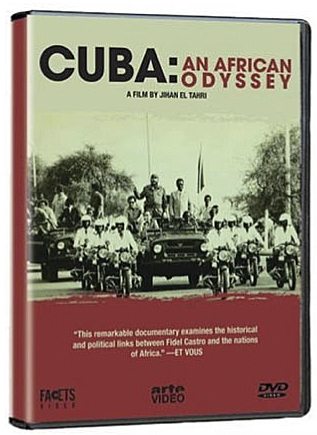
Cuba: an African Odyssey (2008)
Directed By: Jihan El Tahri
Produced By: Jihan El Tahri, Tancrede Ramonet
Brief Description: I was inspired to write a review of this interesting documentary because I read another excellent review by “Mark” on Amazon.com; to my amazement he had been lambasted for his review merely because of ideological reasons, so I decided to wade into the contoversial waters of the literary and political fray. I know something about this topic, not only because it’s an area of my own historic expertise, but also because one of my favorite uncles was conscripted in the Cuban army and was a participant in this Cuban adventure, serving honorably in Angola.
This documentary should have been entitled Cuba — African adventurism and combat by proxy in the superpower conflict during the Cold War.
This is a well-done but terribly biased documentary that glorifies communist Cuba and her heroes in the repressive pantheon of the workers’ paradise. Part 1 of this documentary relates to the Congo and the war for independence from Belgium. Then it proceeds with the struggle for power between communist Patrice Lumumba, who is idolized, and his successor, Laurent Kabila, against (Joseph) Mobutu Sese Seko (1930-1997), who eventually won and ruled with an iron hand as a socialist dictator.
Che Guevara enters the picture in this Congolese civil war and despite hero-worship treatment for this communist icon, the producers are forced to admit that Che’s misadventure was a disastrous and colossal failure. We are not told, however, that if there was a real communist hero, it was General Arnaldo Ochoa, who rescued Che from the claws of his enemies in 1965, when the Argentinean now in full retreat got lost and nearly perished trying to reach Lake Tanganyika, his desperate escape route. General Ochoa, who later became a potential political opponent of Fidel Castro, was accused of drug smuggling and shot in Cuba as a scapegoat after a kangaroo trial in 1989.
Token Americans — e.g., CIA operative Larry Devlin, who must admit to his cloak and dagger operations during the interview — are used to give the documentary a semblance of balance. But the fact remains that the glorification of the war against neocolonialism and the exaltation of communist heroes both Cubans and Africans — not just big fish like Lumumba and Che Guevara but even lesser known communist Cuban revolutionaries, such as Victor Dreke and Harry Villegas, assistants to Che Guevara and who provide some of the narration — are given paramount importance. This glorification of communism and the idolization of revolutionary heroes is all pervasive in the documentary, and facts, logic, and understanding are subordinated to hard reality.
It is highly ironic (although the producers failed to see the irony) that when the Cuban revolutionaries entered the Congo, Victor Dreke, a black Cuban, was given the nom de guerre “Moya,” and the Congolese were told that he was the supreme “Commander of the Congo Mission.” They were astounded and in awe because “Moya” was black and ranked higher than the two white Cubans (of course it was a lie, one of the two whites was Che, whose nom de guerre was “Tatu”!) After Che’s identity was ascertained, the astonishment passed unnoticed. Che was then worshiped as a demigod and the Africans were afraid for his safety and that “something” might happen to him. Nothing was said of the brutality of his African comrades’ tribal warfare, to the point that Che himself was revolted by his African confreres’ barbarism.
Part 2 of the documentary deals with Cuba’s major involvement in the collapse of the Portuguese African colonies in Angola and Mozambique. Nothing is said of the major role played by the left-wing Portuguese military junta, which actually was the biggest player in that collapse. Withdrawal of colonial troops from the Portuguese colonies by the sympathetic, left-wing junta facilitated the work of the African national liberation movements in Cabo Verde, Mozambique, and Angola in 1975. Selective omissions like this favoring the leftist revisionism, unfortunately haunt this documentary.
I also agree with the aforementioned Amazon.com reviewer, “Mark,” that in the Angola war, the communist MPLA were treated as heroes, while the U.S.-supported UNITA fighters were insufficiently covered, intimating only that they were U.S. puppets! You would never know that Dr. Jonas Savimbi was the greatest guerrilla and military leader in both that war, as well as the war for independence in Angola, nor that he was assassinated in 2002 while still fighting!
I am also in accord with the reviewer about the venial situation of the Angolan communist regime and Western oil companies propping up the corrupt regime and accepting protection from the Cuban army in the oil fields. This is not discussed, I suppose, because it would taint the revolutionary image of Agostinho Neto, head of the MPLA and later communist dictator of Angola.
In short, this documentary was well-researched, had good footage, but it was tremendously one-sided, exalting the heroes of the communist pantheon and at times even omitting inconvenient facts that would oppose the leftist perspective of the producers. Finally, the documentary failed to tell the viewers about the corruption (Angola), depredation (Mozambique) and even genocidal perversity (Ethiopia, the Derg, and Mengistu Haile Marian) that the Cuban communist troops, the Soviets, and African socialism left in their wake. You will not see the atrocities of African communists in this documentary, only exaltation of Cuba’s adventurism in Africa during the Cold War. By all means watch this documentary, but only after reading about this topic so that the viewer is prepared to separate the wheat from the chaff.
Rating: 3-star historical-political documentary recommended by MAF with aforementioned caveats.
Theatrical Trailer: https://www.youtube.com/watch?v=ztqxOmDBjXk

No Direction Home (2005)
Directed By: Martin Scorsese
Produced By: Susan Lacy, Jeff
Rosen, Martin Scorsese, Nigel Sinclair, Anthony Wall
Starring: Bob Dylan
Music By: Bob Dylan
Brief Description: Martin Scorsese’s documentary “No Direction Home” (run time: 207 minutes) is truly a masterpiece about the life, times, and music of the legendary Bob Dylan, and contains great surprises about Dylan’s attitude toward the media, politics, and philosophy of life.
Produced by the Academy Award winning director, Scorsese brilliantly recreates, through personal interviews with friends and colleagues, events in the extraordinary life of Bob Dylan, from his upbringing in the small American town in the hinterland of Minnesota, “to his early days in the coffee houses of Greenwich Village, to his tumultuous ascent to pop stardom in 1966.”
The inclusion of the interview with Maria Muldaur (“Midnight at the Oasis”) proves essential to help clarify several aspects of Dylan’s closely guarded details about his personal life and politics. Likewise, interviews with Paul Clayton and Dave Van Ronk, folksinger friends of Dylan, fill in other details about Dylan’s life and music. In an interview with Joan Baez, the singing legend and political star who was so attracted to Bob Dylan, Baez states that no matter how much she tried, she could never decipher Dylan’s mind. Finally in an interview with Allen Ginsberg, the left-wing poet and activist, Ginsberg reminisces that he loved Dylan’s music, but like Baez, he could not penetrate his mind and thoughts.
There are two salient aspects of this documentary about Bob Dylan’s life that the viewer will not forget. One is the intensive opposition Bob Dylan encountered from his early fans and friends when he successfully diversified his music to include rock music. He was accused of being a “traitor” to folk music and reviled. Left-wing folksinger, Pete Seeger, who considered folk singing and ballads his personal, political-left, musical fiefdom, even tried to cut off the sound at a folk music concert, when Dylan and his band went on to play rock music!
The other aspect is Bob Dylan’s impenetrable refusal to allow the media to unraveled the details of his personal life and the true meaning of his philosophy (political or otherwise) of music. Bob Dylan kept on remonstrating that he was only a musician, “not the conscience of the protest movement,” as the New Left and the media kept insisting.
Dylan’s performances in this documentary include: ‘Blowing in the Wind’ (live on TV, 1963); ‘Girl on the North Country’ (unaired Canadian TV special ‘Quest,’ 1964); ‘Man of Constant Sorrow’ (live on TV, 1964); ‘Mr Tambourine Man’ (Newport Folk Festival, 1964); ‘Like a Rolling Stone’ (Live from New Castle, England, 1965), etc.
According to the insert, this DVD set also contains “never-before-seen footage, exclusive interviews, and rare concert performances — the untold story of a living American legend.” I must concur. Scorsese has constructed a well-deserved, documentary hagiography of Bob Dylan that his fans will never forget. His place in folk and rock music and political history in the turbulent Sixties and Seventies is now solidly engraved in stone!
I should also add that Bob Dylan’s published memoirs, Chronicles (Vol. I, 2004, Simon and Schuster) is also recommended as a supplemental road map for those who might get lost among the many music personalities who enter in and out of Bob Dylan’s life in the epic documentary. I found Chronicles to be a magnificent little prop to have handy as you watch the documentary a second time, and to help identify the colorful characters interviewed and mentioned in the documentary.
Rating: 5-star documentary recommended by MAF.
Theatrical Trailer: http://www.youtube.com/watch?v=QOUtzHizr9A
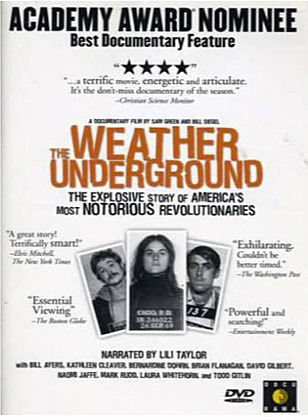
The Weather Underground (2004)
Directed By: Sam Green, Bill Siegel
Produced By: Carrie Lozano
Narrated By: Lili Taylor
Brief Description: A historical-political documentary, “The Weather Underground — The Explosive Story of America’s Most Notorious Revolutionaries” features former members of that Destructive Generation, including Bill Ayers, Bernadine Dohrn, Mark Rudd, Brian Flanagan, Naomi Jaffe, Laura Whitehorn, David Gilbert, Kathleen Cleaver, and Todd Gitlin. The running time of this splendid documentary is 95 minutes.
Originating in 1969 as a radical faction of the leftist Students for a Democratic Society (SDS), the Weathermen organization took its name from Bob Dylan’s song, “Subterranean Homesick Blues,” whose lyrics stated: “You don’t need a weatherman to know which way the wind blows.” According to Wikipedia, “that phrase was also used in the title of a position paper the Weathermen distributed at the Students for a Democratic Society (SDS) convention in Chicago on June 18, 1969.” (It is of great interest that later taking a hint from the Soviets who declared Bob Dylan a “capitalist” rather than a revolutionary, the organization changed its name to the Weather Underground.)
Reflecting the political views expressed in the documentary, Netflix sympathetically describes the film as “a sobering documentary about a group of 1960s ‘committed freedom fighters’ known as The Weather Underground. A radical offshoot of the Students for a Democratic Society, the weathermen didn’t just march or sit in, they rioted and bombed — not to change the American political scene but rather to destroy it. The organization was part of a global trend of evolution that sprang from the belief that not acting against violence is violence.”
The name of that organization became synonymous with acts of violence. This group of domestic terrorists “conducted a campaign of bombings through the mid-1970s, including aiding the jailbreak and escape of Timothy Leary. The ‘Days of Rage’, their first public demonstration on October 8, 1969, was a riot in Chicago timed to coincide with the trial of the Chicago Seven. In 1970 the group issued a ‘Declaration of a State of War’ against the United States government, under the name ‘Weather Underground Organization’ (WUO). The bombing attacks mostly targeted government buildings (e.g., U.S. Capitol, the Pentagon, and the U.S. Department of State), along with several banks…Then on October 20, 1981 in Nanuet, New York, the group robbed a Brinks armored truck containing $1.6 million. The robbery was violent, resulting in the murders of two police officers and a security guard. WUO former members Kathy Boudin, Judith Alice Clark, and David Gilbert were found guilty and sentenced to lengthy prison terms. The documentary The Weather Underground described the Brinks Robbery as the ‘unofficial end’ of the Weather Underground.” (From Wikipedia, “Weather Underground”)
Most of the Weather Underground members eventually turned themselves in to federal authorities, but were either fined and put on probation or released due to legal technicalities (e.g., the FBI collection of evidence and surveillance of suspected members were deemed illegal by the courts, etc.).
Two of the former members of the Weather Underground were still serving their 75-year prison terms at the time the documentary was released, and several other members appear to still be living in the Sixties, except Todd Gitlin and Brian Flanagan.
Gitlin, a founding member of SDS who never joined the Weather Underground (considering them part of the radical faction that hijacked his organization), gives a great rebuttal to the mostly unrepentant radical cast. Another repentant member of SDS, Brian Flanagan, a bar owner and a $28,000 winner on the TV show Jeopardy, also renounced his radical ideologies, expressing regret for his actions and comparing the WUO’s acts to terrorism stating “When you feel that you have right on your side, you can do some pretty horrific things.”
From watching the documentary, viewers would never realize that Kathleen Cleaver, wife of ex-Black Panther leader Eldridge Cleaver, has also recanted her radical, left-wing sentiments; and Mark Rudd, a professor of mathematics at Central New Mexico Community College, admitted he still has feelings of “guilt and shame” 30 years later stating, “These are things I am not proud of, and I find it hard to speak publicly about them…”
This is an excellent documentary but it could have benefitted from a little more balance, perhaps from someone on the right, such as David Horowitz, who would have enhanced the political equilibrium.
Finally, Brian Flanagan’s observation summarizes it, “the Vietnam War drove us crazy….” I would add and expound on Flanagan’s sentiments: Once a group of radicals believe they have rightness and social justice on their side, violence, crime and terrorism, become accepted methods for bringing about change, even when the American and Western culture that they so despised and attacked was the best society that human minds had yet created in man’s ascent in the turbulent history of progress. This statement is still relevant today in view of the horrific 911 attack and Islamic fanaticism.
Rating: 4-star historical-political documentary recommended by MAF.
Theatrical Trailer: https://www.youtube.com/watch?v=uiAbHmwIwGs
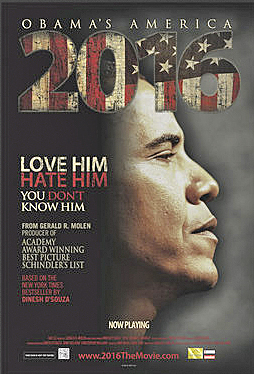
2016 Obama’s America (2012)
Directed By: Dinesh D’Souza and
John Sullivan
Produced By: Gerald R. Molen
Brief Description: As the cover reads, “Love him, hate him. You don’t know him.” 2016 Obama’s America examines the question, “If Obama wins a second term, where will we be in 2016?”
Amazon’s description also reads: “Immersed in exotic locales across four continents, best selling author Dinesh D’Souza races against time to find answers to Obama’s past and reveal where America will be in 2016. During this journey he discovers how Hope and Change became radically misunderstood, and identifies new flashpoints for hot wars in mankind’s greatest struggle. The journey moves quickly over the arc of the old colonial empires, into America’s empire of liberty, and we see the unfolding realignment of nations and the shape of the global future.”
Observant reviewers at Amazon.com have pointed out the inconsistency of so many trashy one-star review ratings by Obama partisans. The reality is that this documentary is a well-done, artistic, thoroughly documented film. The unjust criticisms at Amazon.com by Obama partisans show that man can be an unfair, political animal. In the case of the background and performance of President Barack Obama, the unfairness has been taken to extremes by his apologists. Frankly, these “reviewers” have not been intellectually honest and have given bad ratings to a masterful documentary they could not have seen, or if they have, they plainly rated it dishonestly.
We can disagree about the ultimate political bent of the film, but not about the documentation of hard, cold facts that can be checked out plainly by those who do not fear facing cold reality. The documentary is in fact very fair to Obama — revealing but not shocking, informing while entertaining. It may be too cerebral for some who have become too used to the Jerry Springer-type of sensationalism or Rousseauian emotionalism. But some intellectual challenge is occasionally needed for something as serious as a presidential contest approaching and an incumbent president who despite a mediocre performance, has been sheltered and shielded by the American press and media.
Because of the political polarization of this documentary, this film will be most helpful to those who consider themselves centrists and independents. It is an essential film for those who are still undecided. As I have noted, Democrats are panning these movies not only for what it reveals, but for what they think it reveals. Many Republicans do not think this movie goes far enough in exposing all the revelations, but have nevertheless given it the commendable good ratings it deserves.
And because detractors of President Obama have been unfairly labeled in some cases “Neanderthals” or racists by partisan Democrats, it should be noted the executive producer, co-director, and co-writer of this film is Dinesh D’Souza, not an “angry white male,” but an Indian-born intellectual, an eminent college president.
Mr. Dinesh D’Souza and associates should be commended for carrying out a masterful piece of investigative journalism and producing an exemplary documentary, doing the homework that should have been performed by the mainstream media at least since to 2008 and which the American press still refuses to carry out, even as we approach the momentous November 2012 Presidential U.S. elections. Do your civic duty, see this film.
Rating: 5-star historical-political documentary recommended by MAF.
Theatrical Trailer: https://www.youtube.com/watch?v=dPoLHqV56Ms
Written and Reviewed by Dr. Miguel Faria
Copyright ©2011-2012 Miguel A. Faria, Jr., M.D.
4 thoughts on “Classic Movies and Documentaries”
Lost Highway by David Lynch — A review by an Amazon customer: I think Lost Highway is easier to understand than people think.
In interviews with David Lynch, he talks about the OJ Simpson murder case, how, in his mind, OJ was indeed guilty, and what he must have to create in his mind to live a normal life after such a violent and horrific act. Lynch also said, the film is “very much about psychogenic fugue” (now known as Dissociative fugue). So, taking what Lynch said, and reading about the symptoms of Dissociative fugue, I have come up with my own interpretation of the movie. The first shot we see, is Fred Madison’s (Bill Pullman) fugue (Latin for ‘flight’) as he drives the dark highway. The film has begun even as the credits roll, and Fred has already killed his wife and lover. The entire film, save for the opening shot, and last scene where the cops have caught on, and are in hot pursuit, is happening in his mind. The video images represent reality, something Fred wants to escape from; they show the evidence of his guilt. Fred re-interprets reality and invents identities. He wants to remember the events the way he likes to, “not necessarily the way it happened.” All of this, the whole story in the film, is taking place in Fred’s mind, as he flees the scene in his car. Fred is in a fugue state, until he slowly realizes, bit by bit, that he really did kill and dismember his wife. So in the last scene, Fred is caught, and being chased by police, in real time. Fred’s fugue state ends in him completely freaking out, he is a monster, he can no longer escape into his idyllic ‘Pete’ fantasy. The last shot is the total mental breakdown of Fred’s mind. Anyway, until something better comes along, that’s how I read Lost Highway. It’s actually less complex than I thought on my first viewing.— Nats, Amazon, Sept. 29, 2016
I have to disagree about the film Kingdom of Heaven. The message in this movie was made to pander to Muslims post 9/11. The Christians were obviously the bad guys here and the message was anti Christianity. In reality the first Crusaders were not lead by a Christian but were lead by a Greek named Heraclius in 622AD (later became a Christian). Greece was conquered by the Slavs and Jerusalem had fallen to the Persians (nearly 150 years before Islam).Christianity was in chaos at the time. Heraclius, along with financial help from the Orthodox Church, raised an army of peasants. With the promise of land ownership (in Eastern Europe) he marched on the Persians and drove them out of Jerusalem. He also drove the Slavs from Greece. This was the beginning of the Byzantine Empire.—WM (FB, Sept 22, 2023)
——
I’m sorry, your history is wrong. Heraclius, was a Christian general in the Byzantine army (a Greek-speaking officer but part of the surviving Eastern Roman or Byzantine Empire), and he not only executed the villain Emperor Phocas, but also founded a new Byzantine dynasty in the 7th century. It was he who defeated and drove away the Sassanian Persians, who were Zoroastrians, not Muslims. After a victorious but exhausting war, Heraclius and his exhausted Byzantine army withdrew to Constantinople, when suddenly the Middle East was assailed and swamped by the NEW enemies of Western civilization, the Arabs, who brought a new religion with a new fanaticism not seen up to that time— Islam! Consider that the First Crusade took place in In 1095, proclaimed by Pope Urban II, and Heraclius lived and was Byzantine Emperor, four centuries earlier from AD 610-641, a hell of a historical discrepancy! Besides, the actions of this movie take place between between the Second (1144-1150) and Third (1189-1192) Crusades! I agree that the film does pander to the Muslims. But Hollywood panders to the enemies of Christianity, especially the Catholic Church, and all of Western Civilization! And it is difficult to find any movie that does not do homage to leftist views in race, politics, economics, and that does not slander the Christian religion, except for those films produced by Mel Gibson! Leftist bias is pervasive in Hollywood, and for anything to be funded and produced, some agenda has to be followed, socialist propaganda promulgated, and often enough it includes outright and offensive anti-American and anti-Catholic diatribes! Yes, the movie panders to the Muslims but it’s still a fantastic movie that despite some inaccuracies, is still worth watching! Unfortunately, the historic gist of the movie and the outcome is accurate. Your source, frankly, is incorrect. I recommend you read Will Durant’ The Story of Civilization, Volume IV, “The Age of Faith,” a hefty tome but worth reading, or some other reputable historian. — Dr. Miguel A. Faria
Day of the Siege : On September 11, 1683, the Poles saved Christendom and Western civilization, when the fate of the West truly hung in the balance. The almost legendary Polish king, Jan III Sobieski defeated the grand Ottoman army led by Kara Mustafa, the Grand Vizier of the Ottoman Turks himself! The Turks amassed a 300,000 man army against a divided Christendom. The salvation of the Christians was stopping them in the fortified and besieged city of Vienna, “the golden Apple.” The mounted Polish cavalry, the winged hussars, led by their king, Jan Sobieski — 40,000 men who turned out to be only 20,000 in number— led the Christians to victory and saved the West! We owe that to the Poles! 💜🙏🫵😎
The best article I have seen on Ethiopia, the Derg, and Haile Selassie
https://www.dw.com/en/how-does-ethiopia-remember-haile-selassie/a-70177173